Paul van Yperen's Blog, page 356
February 2, 2016
Fien de la Mar
Tonight at the International Film Festival Rotterdam is the world premiere of Ik wil gelukkig zijn/One Life is not enough (2016). Annette Apon directed this documentary about one of the few real film stars of the Netherlands, Fien de la Mar (1898-1965). This Dutch Diva starred in several films during the 1930s when a Dutch Hollywood was created by German emigrants like Richard Oswald, Ludwig Berger and Max Ophüls. Fien sang a song about this curious phenomenon in the short film Hollandsch Hollywood/Dutch Hollywood (Ernst Winar, 1933).
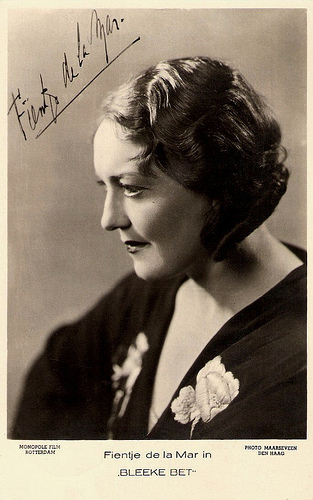
Dutch Postcard by Monopole Film, Rotterdam. Photo: Dick van Maarseveen. Publicity still for Bleeke Bet (1934).
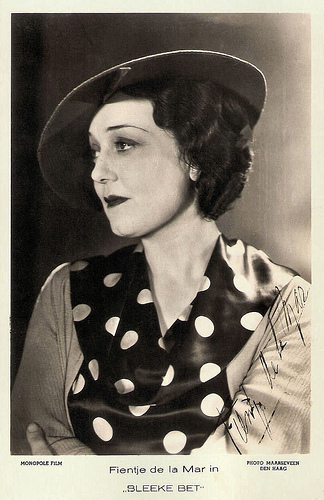
Dutch postcard by M.B. & Z. (M. Bonnist & Zonen, Amsterdam). Photo: Dick van Maarseveen, Den Haag / Monopole Film. Publicity still of Fien(tje) de la Mar in Bleeke Bet (Alex Benno, Richard Oswald, 1934). Collection: Egbert Barten.
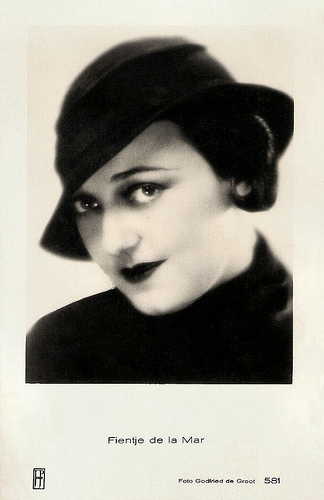
Dutch postcard by JosPe. Sent by mail in 1935. Photo: Godfried de Groot .
Capricious
Before WW II, the actress and cabaret artist was known as Fientje de la Mar. She was born in 1898 and named after Josephine de Beauharnais, the first wife of Napoleon Bonaparte.
Her grandfather Charles de la Mar was an admirer of the French emperor and had called his son Napoleon (Nap). Both were famous Dutch actors and Fien started her stage career in 1917 when she was still a school girl.
Immediately Fientje showed talent but also a huge temper. She would become a glamorous and capricious stage star, who loved liquor and would have many lovers.
Her feature film debut was the extremely successful musical De Jantjes/The Tars (Jaap Speyer, 1934), one of the first Dutch sound films. The three title characters were played by Willy Costello , Johan Kaart and Fien's lover Jan van Ees .
Fien's second feature was Bleeke Bet (Richard Oswald, Alex Benno, 1934). In this film she sings her torch song Ik wil gelukkig zijn (I want to be happy).
Bleeke Bet (1934) was based on a popular stage melodrama by Herman Bouber, who also wrote the screenplay. His wife, Aaf Bouber played the title role, a greengrocer of the Jordaan, the old neighbourhood in Amsterdam. Bet wants her daughter Jans ( Jopie Koopman ) to marry a rich man, but Jans loves sailor Ko (the young Johannes Heesters - right on the photo).
The film was a success and would be re-issued in 1941 and 1961. In 1941 the Jewish actors like Sylvain Poons (also on the photo) were cut out of the picture by the Nazi censors. Poons as the ice-cream salesman Sally sings an evergreen in the film, IJslied (Ice-cream Song). The music was composed by emigrant Hans May and the lyrics were written by the later collaborator, Jacques van Tol.
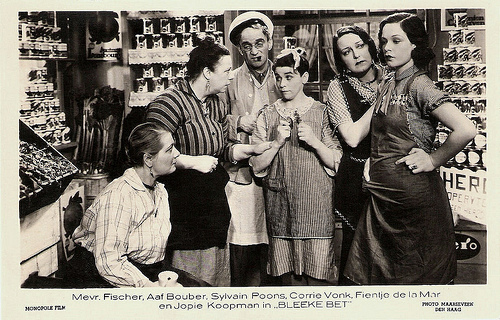
Dutch postcard by Monopole Film, Amsterdam. Photo: Maarseveen, Den Haag. Clara Vischer-Blaaser, Aaf Bouber , Sylvain Poons , Corry Vonk , Fien de la Mar and Jopie Koopman in the Dutch tragicomedy Bleeke Bet (Richard Oswald, Alex Benno, 1936).
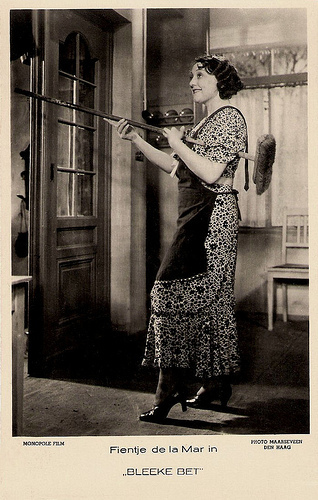
Dutch postcard by M.B. & Z. (M. Bonnist & Zonen, Amsterdam). Photo: Monopole Film / Dick van Maarseveen, Den Haag. Publicity still of Fien(tje) de la Mar in Bleeke Bet (1934).
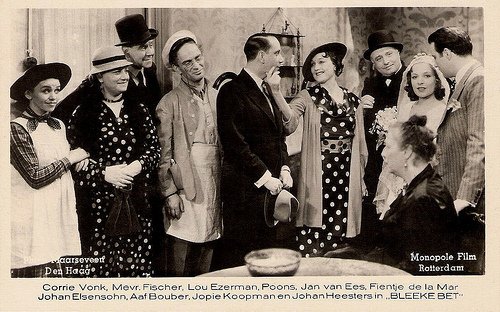
Dutch Postcard. Photo: Dick van Maarseveen. Publicity still for Bleeke Bet (1934).
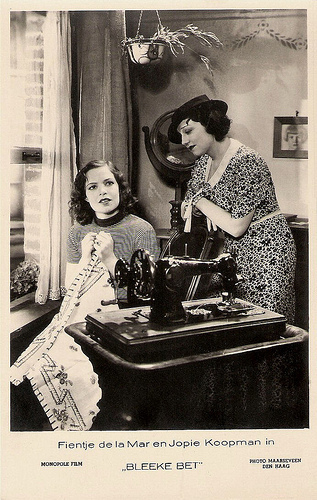
Dutch postcard by Monopole Film, Rotterdam. Photo: Dick van Maarseveen. Publicity still for Bleeke Bet (1934) with Jopie Koopman .
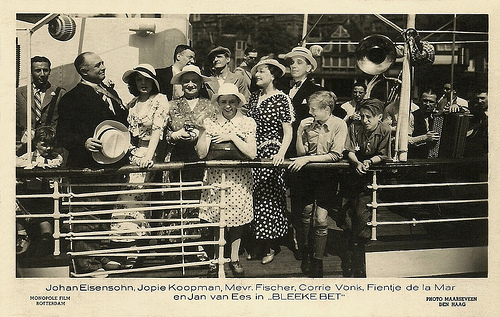
Dutch postcard by Monopole Film, Amsterdam. Photo: Maarseveen, Den Haag. Johan Elsensohn , Jopie Koopman , Clara Vischer-Blaaser, Corry Vonk , Fien de la Mar and Jan van Ees in the Dutch tragicomedy Bleeke Bet (Richard Oswald, Alex Benno, 1934).
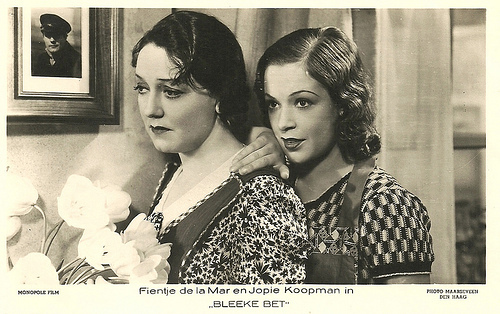
Dutch postcard by Monopole Film. Photo: Maarseveen, Den Haag. Fien(tje) de la Mar and Jopie Koopman in the tragicomedy Bleeke Bet (Alex Benno, Richard Oswald, 1934).
Tragic End
Bleeke Bet proved to be another hit and the following year Fien de la Mar would star in three more films. In the musical Op stap/On the Road (Ernst Winar, 1935) she sang a song, spectacularly accompanied by a dozen pianos.
Her co-star in this film was Frits van Dongen who later would have a Hollywood career as Philip Dorn. They also appeared together in the comedy De Big van het regiment/The Regiment's Mascot (Max Nosseck, 1935).
Her later films include Klokslag twaalf/12 'O Clock (Léo Joannon, 1936) - an alternate language version of Quand minuit sonnera (Léo Joannon, 1936) starring Marie Bell , De spooktrein/The Ghost Train (Carl Lamac, 1939) with Jan Musch , and Ergens in Nederland/Somewhere in the Netherlands (Ludwig Berger, 1940) with Lily Bouwmeester and actor-author Jan de Hartog.
A few weeks after the premiere of the latter film the Second World War started and the film was forbidden by the Nazis. In 1943 Fien refused to work for the Nazi regime and her career halted.
After the war she made a glorious stage come-back and she even had her own theatre for a while. She worked for television, but would not make any more films.
Her life ended tragically in 1965. Fien de la Mar jumped out of the window of her Amsterdam apartment and died a few days later in a hospital. Her legend is kept in an excellent biography by Jenny Pisuisse (1982), a CD and in the stage and television musical Fien (Jan Keja, 1985) with Jasperina de Jong as Fien. And now there is this new documentary by Annette Apon.
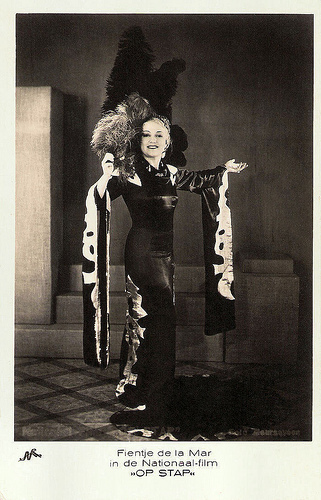
Dutch postcard by M.B. & Z. (M. Bonnist & Zonen, Amsterdam). Photo: Dick van Maarseveen, Den Haag / Nationaal Film. Publicity still of Fien(tje) de la Mar in Op stap/On the Move (Ernst Winar, 1935) .
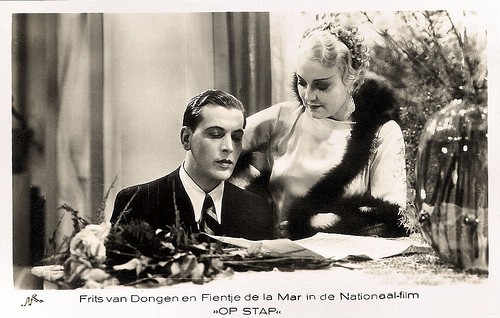
Dutch postcard by M.B. & Z. (M. Bonnist & Zonen, Amsterdam). Photo: Dick van Maarseveen, Den Haag / Nationaal Film. Publicity still for Op stap/On the Move (Ernst Winar, 1935) with Frits van Dongen .
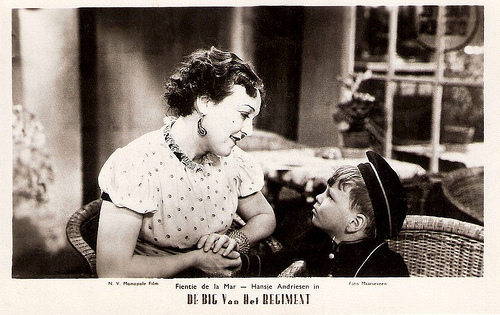
Dutch postcard by NV Monopole Film. Photo: Maarseveen. Fien(tje) de la Mar and Hansje Anderiesen (aka Jansje Andriessen and Hansje Andriesen) in De Big van het regiment (Max Nosseck, 1935).
Fien de la Mar sings Hollandsch Hollywood (1934). Source: Henk Brugge (YouTube).
Clip from Bleeke Bet (1934) with Fien singing Ik wil gelukkig zijn. Source: Brassens66 (YouTube).
Final scene from Op stap/On the Road (1935). Source: CaptainvonTrapp (YouTube).
Trailer for Ik wil gelukkig zijn/One Life is not enough (2016). Source: SNG Film (YouTube).
Sources: Wikipedia, Wim Ibo (Huygens ING) and .

Dutch Postcard by Monopole Film, Rotterdam. Photo: Dick van Maarseveen. Publicity still for Bleeke Bet (1934).

Dutch postcard by M.B. & Z. (M. Bonnist & Zonen, Amsterdam). Photo: Dick van Maarseveen, Den Haag / Monopole Film. Publicity still of Fien(tje) de la Mar in Bleeke Bet (Alex Benno, Richard Oswald, 1934). Collection: Egbert Barten.

Dutch postcard by JosPe. Sent by mail in 1935. Photo: Godfried de Groot .
Capricious
Before WW II, the actress and cabaret artist was known as Fientje de la Mar. She was born in 1898 and named after Josephine de Beauharnais, the first wife of Napoleon Bonaparte.
Her grandfather Charles de la Mar was an admirer of the French emperor and had called his son Napoleon (Nap). Both were famous Dutch actors and Fien started her stage career in 1917 when she was still a school girl.
Immediately Fientje showed talent but also a huge temper. She would become a glamorous and capricious stage star, who loved liquor and would have many lovers.
Her feature film debut was the extremely successful musical De Jantjes/The Tars (Jaap Speyer, 1934), one of the first Dutch sound films. The three title characters were played by Willy Costello , Johan Kaart and Fien's lover Jan van Ees .
Fien's second feature was Bleeke Bet (Richard Oswald, Alex Benno, 1934). In this film she sings her torch song Ik wil gelukkig zijn (I want to be happy).
Bleeke Bet (1934) was based on a popular stage melodrama by Herman Bouber, who also wrote the screenplay. His wife, Aaf Bouber played the title role, a greengrocer of the Jordaan, the old neighbourhood in Amsterdam. Bet wants her daughter Jans ( Jopie Koopman ) to marry a rich man, but Jans loves sailor Ko (the young Johannes Heesters - right on the photo).
The film was a success and would be re-issued in 1941 and 1961. In 1941 the Jewish actors like Sylvain Poons (also on the photo) were cut out of the picture by the Nazi censors. Poons as the ice-cream salesman Sally sings an evergreen in the film, IJslied (Ice-cream Song). The music was composed by emigrant Hans May and the lyrics were written by the later collaborator, Jacques van Tol.

Dutch postcard by Monopole Film, Amsterdam. Photo: Maarseveen, Den Haag. Clara Vischer-Blaaser, Aaf Bouber , Sylvain Poons , Corry Vonk , Fien de la Mar and Jopie Koopman in the Dutch tragicomedy Bleeke Bet (Richard Oswald, Alex Benno, 1936).

Dutch postcard by M.B. & Z. (M. Bonnist & Zonen, Amsterdam). Photo: Monopole Film / Dick van Maarseveen, Den Haag. Publicity still of Fien(tje) de la Mar in Bleeke Bet (1934).

Dutch Postcard. Photo: Dick van Maarseveen. Publicity still for Bleeke Bet (1934).

Dutch postcard by Monopole Film, Rotterdam. Photo: Dick van Maarseveen. Publicity still for Bleeke Bet (1934) with Jopie Koopman .

Dutch postcard by Monopole Film, Amsterdam. Photo: Maarseveen, Den Haag. Johan Elsensohn , Jopie Koopman , Clara Vischer-Blaaser, Corry Vonk , Fien de la Mar and Jan van Ees in the Dutch tragicomedy Bleeke Bet (Richard Oswald, Alex Benno, 1934).

Dutch postcard by Monopole Film. Photo: Maarseveen, Den Haag. Fien(tje) de la Mar and Jopie Koopman in the tragicomedy Bleeke Bet (Alex Benno, Richard Oswald, 1934).
Tragic End
Bleeke Bet proved to be another hit and the following year Fien de la Mar would star in three more films. In the musical Op stap/On the Road (Ernst Winar, 1935) she sang a song, spectacularly accompanied by a dozen pianos.
Her co-star in this film was Frits van Dongen who later would have a Hollywood career as Philip Dorn. They also appeared together in the comedy De Big van het regiment/The Regiment's Mascot (Max Nosseck, 1935).
Her later films include Klokslag twaalf/12 'O Clock (Léo Joannon, 1936) - an alternate language version of Quand minuit sonnera (Léo Joannon, 1936) starring Marie Bell , De spooktrein/The Ghost Train (Carl Lamac, 1939) with Jan Musch , and Ergens in Nederland/Somewhere in the Netherlands (Ludwig Berger, 1940) with Lily Bouwmeester and actor-author Jan de Hartog.
A few weeks after the premiere of the latter film the Second World War started and the film was forbidden by the Nazis. In 1943 Fien refused to work for the Nazi regime and her career halted.
After the war she made a glorious stage come-back and she even had her own theatre for a while. She worked for television, but would not make any more films.
Her life ended tragically in 1965. Fien de la Mar jumped out of the window of her Amsterdam apartment and died a few days later in a hospital. Her legend is kept in an excellent biography by Jenny Pisuisse (1982), a CD and in the stage and television musical Fien (Jan Keja, 1985) with Jasperina de Jong as Fien. And now there is this new documentary by Annette Apon.

Dutch postcard by M.B. & Z. (M. Bonnist & Zonen, Amsterdam). Photo: Dick van Maarseveen, Den Haag / Nationaal Film. Publicity still of Fien(tje) de la Mar in Op stap/On the Move (Ernst Winar, 1935) .

Dutch postcard by M.B. & Z. (M. Bonnist & Zonen, Amsterdam). Photo: Dick van Maarseveen, Den Haag / Nationaal Film. Publicity still for Op stap/On the Move (Ernst Winar, 1935) with Frits van Dongen .

Dutch postcard by NV Monopole Film. Photo: Maarseveen. Fien(tje) de la Mar and Hansje Anderiesen (aka Jansje Andriessen and Hansje Andriesen) in De Big van het regiment (Max Nosseck, 1935).
Fien de la Mar sings Hollandsch Hollywood (1934). Source: Henk Brugge (YouTube).
Clip from Bleeke Bet (1934) with Fien singing Ik wil gelukkig zijn. Source: Brassens66 (YouTube).
Final scene from Op stap/On the Road (1935). Source: CaptainvonTrapp (YouTube).
Trailer for Ik wil gelukkig zijn/One Life is not enough (2016). Source: SNG Film (YouTube).
Sources: Wikipedia, Wim Ibo (Huygens ING) and .
Published on February 02, 2016 22:00
February 1, 2016
Imported from the USA: Kim Novak
American film and television actress Kim Novak (1933) starred in such popular successes as Picnic (1955), The Man with the Golden Arm (1955) and Pal Joey (1957). However, she is perhaps best known today for her ‘dual role’ as both Judy Barton and Madeleine Elster in Alfred Hitchcock's classic thriller Vertigo (1958). She withdrew from acting in 1966, but returned sporadically in European films.
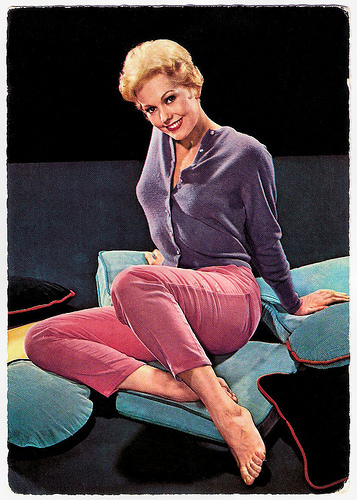
German postcard by Krüger, no. 902/29.
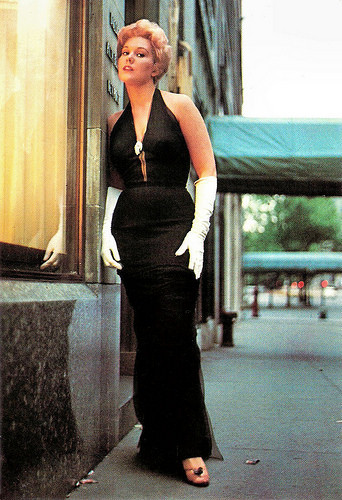
Spanish postcard by Postal Oscarcolor, no. 372.
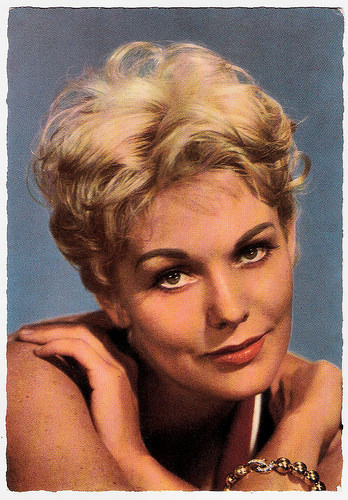
French postcard by E.D.U.G., no. 128.
Miss Deepfreeze
Kim Novak was born as Marilyn Pauline Novak, professionally in Chicago, Illinois in 1933. She is the daughter of history teacher Joseph Novak and factory worker Blanche (née Kral) Novak.
She won two scholarships to the School of the Art Institute of Chicago, and during the summer break in her last semester of junior college, Novak went on a cross-country tour modeling for a refrigerator company at trade shows. While stopping by Los Angeles, Novak was crowned Miss Deepfreeze by the refrigerator company.
While there, she and two other models stood in line to be extras in The French Line (Lloyd Bacon, 1954), a film starring Jane Russell. It was here that she was discovered by an agent, who signed her to a long-term contract with Columbia Pictures. Columbia intended for Novak to be their successor to Rita Hayworth, their biggest star of the 1940s, whose career had declined. The studio also hoped that Novak would bring them the same success 20th Century-Fox was having with Marilyn Monroe.
Her first role for the studio was in the film noir Pushover (Richard Quine, 1954). She then co-starred in the romantic comedy Phffft! (Mark Robson, 1954) as Janis, a Monroe-type character who finds Jack Lemmon's character, Robert Tracey, "real cute". Both films were reasonably successful at the box office, and Novak received favorable reviews for her performances.
The film version of Picnic (Joshua Logan, 1955), co-starring William Holden, was a resounding critical and box office triumph. Novak won a Golden Globe Award for Most Promising Newcomer. She was also nominated for BAFTA Film Award for Best Foreign Actress, but did not win. Director Otto Preminger then cast her in The Man with the Golden Arm (1955), in which she played Frank Sinatra's sultry ex-girlfriend. The film was a box office triumph.
After appearing in a series of successful movies, Novak became one of the biggest box office draws. Columbia placed her in a film adaptation of Pal Joey (George Sidney, 1957). She played Linda English, a naive showgirl, opposite Frank Sinatra and Rita Hayworth. The movie was a box office hit and has been considered one of Novak's better performances.
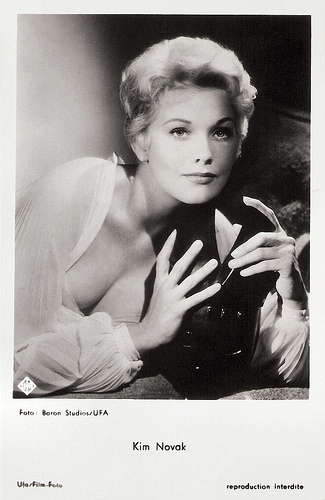
French postcard by Editions P.I., Paris, no. FK 3287. Photo: Baron Studios / Ufa.
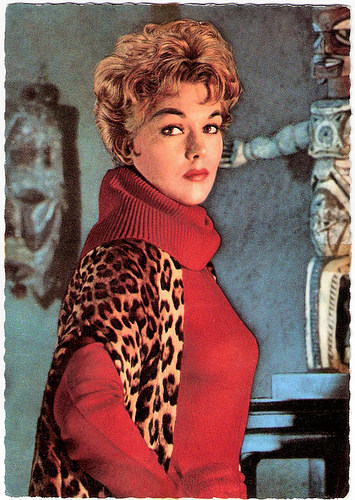
German postcard by Ufa, Berlin-Tempelhof, no. CK 280. Photo: Terb Agency.
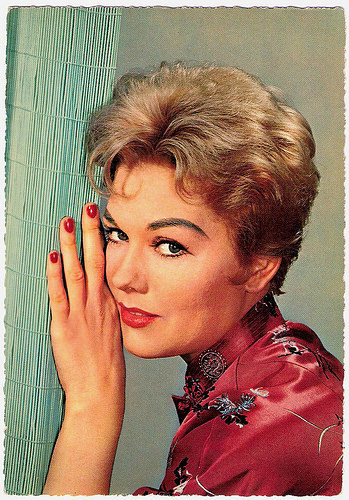
German postcard by Krüger, no. 902/27.
Vertigo
Kim Novak is perhaps best known today for the classic thriller Vertigo (Alfred Hitchcock, 1958), opposite James Stewart. During the production, Novak was striking for more money from Columbia, and refused to show up for work on the Vertigo set to protest her salary of $1,250 a week. Novak hired new agents to represent her and demanded an adjustment in her contract. Harry Cohn of Columbia suspended her but, after a few weeks of negotiations, he relented and offered her a new contract worthy of a major star. Vertigo was poorly received at the time of its release in 1958 and failed at the box office, but has since been re-evaluated and is widely considered one of the director's best works.
Sandra Brennan at AllMovie: "In 1958, Novak appeared in her most famous role, that of enigmatic Madeleine in Alfred Hitchcock's masterpiece Vertigo. It was a difficult role, but one she rose to admirably. She did have one conflict with Hitchcock on the set concerning the stiff gray suit and black shoes she would be required to wear for most of the picture. When she saw costume designer Edith Head's original plans for the suit, Novak, fearing the suit would be distracting and uncomfortable and believing that gray is seldom a blonde's best color, voiced her concerns directly to Hitchcock who listened patiently and then insisted she wear the prescribed garb. Novak obeyed and to her surprise discovered that the starchy outfit enhanced rather than hindered her ability to play Madeleine."
In 1958, Novak again worked with Stewart in Richard Quine's Bell, Book and Candle, a comedy tale of modern-day witchcraft, that proved to be a box office success. The following year, she starred opposite Fredric March in the acclaimed drama Middle of the Night (Delbert Mann, 1959), and opposite Kirk Douglas in Strangers When We Meet (Richard Quine, 1960).
Although still young, her career declined in the early 1960s, and after several years in a series of lackluster films, she withdrew from acting in 1966. She has only sporadically returned since. She returned to the screen in the West-German film Schöner Gigolo, armer Gigolo/Just a Gigolo (David Hemmings, 1978), starring David Bowie , and the British mystery The Mirror Crack'd (Guy Hamilton, 1980), based on the story by Agatha Christie. She also had a regular role on the prime time TV series Falcon Crest (1986–1987).
After a disappointing experience during the filming of the mystery Liebestraum (Mike Figgis, 1991), Kim Novak has permanently retired from acting, citing she has no desire to return. In 2013, she attended the 2013 Cannes Film Festival where she introduced a new restored version of Vertigo. Audiences gave Novak a standing ovation.
Trailer Picnic (Joshua Logan, 1955). Sources: Craig Steves (YouTube).
Trailer Vertigo (Alfred Hitchcock, 1958). Sources: Ageless Trailers (YouTube).
Trailer The Mirror Crack'd (Guy Hamilton, 1980). Source: Mr 80s Movies (YouTube).
Sources: Sandra Brennan (AllMovie), Wikipedia and .

German postcard by Krüger, no. 902/29.

Spanish postcard by Postal Oscarcolor, no. 372.

French postcard by E.D.U.G., no. 128.
Miss Deepfreeze
Kim Novak was born as Marilyn Pauline Novak, professionally in Chicago, Illinois in 1933. She is the daughter of history teacher Joseph Novak and factory worker Blanche (née Kral) Novak.
She won two scholarships to the School of the Art Institute of Chicago, and during the summer break in her last semester of junior college, Novak went on a cross-country tour modeling for a refrigerator company at trade shows. While stopping by Los Angeles, Novak was crowned Miss Deepfreeze by the refrigerator company.
While there, she and two other models stood in line to be extras in The French Line (Lloyd Bacon, 1954), a film starring Jane Russell. It was here that she was discovered by an agent, who signed her to a long-term contract with Columbia Pictures. Columbia intended for Novak to be their successor to Rita Hayworth, their biggest star of the 1940s, whose career had declined. The studio also hoped that Novak would bring them the same success 20th Century-Fox was having with Marilyn Monroe.
Her first role for the studio was in the film noir Pushover (Richard Quine, 1954). She then co-starred in the romantic comedy Phffft! (Mark Robson, 1954) as Janis, a Monroe-type character who finds Jack Lemmon's character, Robert Tracey, "real cute". Both films were reasonably successful at the box office, and Novak received favorable reviews for her performances.
The film version of Picnic (Joshua Logan, 1955), co-starring William Holden, was a resounding critical and box office triumph. Novak won a Golden Globe Award for Most Promising Newcomer. She was also nominated for BAFTA Film Award for Best Foreign Actress, but did not win. Director Otto Preminger then cast her in The Man with the Golden Arm (1955), in which she played Frank Sinatra's sultry ex-girlfriend. The film was a box office triumph.
After appearing in a series of successful movies, Novak became one of the biggest box office draws. Columbia placed her in a film adaptation of Pal Joey (George Sidney, 1957). She played Linda English, a naive showgirl, opposite Frank Sinatra and Rita Hayworth. The movie was a box office hit and has been considered one of Novak's better performances.

French postcard by Editions P.I., Paris, no. FK 3287. Photo: Baron Studios / Ufa.

German postcard by Ufa, Berlin-Tempelhof, no. CK 280. Photo: Terb Agency.

German postcard by Krüger, no. 902/27.
Vertigo
Kim Novak is perhaps best known today for the classic thriller Vertigo (Alfred Hitchcock, 1958), opposite James Stewart. During the production, Novak was striking for more money from Columbia, and refused to show up for work on the Vertigo set to protest her salary of $1,250 a week. Novak hired new agents to represent her and demanded an adjustment in her contract. Harry Cohn of Columbia suspended her but, after a few weeks of negotiations, he relented and offered her a new contract worthy of a major star. Vertigo was poorly received at the time of its release in 1958 and failed at the box office, but has since been re-evaluated and is widely considered one of the director's best works.
Sandra Brennan at AllMovie: "In 1958, Novak appeared in her most famous role, that of enigmatic Madeleine in Alfred Hitchcock's masterpiece Vertigo. It was a difficult role, but one she rose to admirably. She did have one conflict with Hitchcock on the set concerning the stiff gray suit and black shoes she would be required to wear for most of the picture. When she saw costume designer Edith Head's original plans for the suit, Novak, fearing the suit would be distracting and uncomfortable and believing that gray is seldom a blonde's best color, voiced her concerns directly to Hitchcock who listened patiently and then insisted she wear the prescribed garb. Novak obeyed and to her surprise discovered that the starchy outfit enhanced rather than hindered her ability to play Madeleine."
In 1958, Novak again worked with Stewart in Richard Quine's Bell, Book and Candle, a comedy tale of modern-day witchcraft, that proved to be a box office success. The following year, she starred opposite Fredric March in the acclaimed drama Middle of the Night (Delbert Mann, 1959), and opposite Kirk Douglas in Strangers When We Meet (Richard Quine, 1960).
Although still young, her career declined in the early 1960s, and after several years in a series of lackluster films, she withdrew from acting in 1966. She has only sporadically returned since. She returned to the screen in the West-German film Schöner Gigolo, armer Gigolo/Just a Gigolo (David Hemmings, 1978), starring David Bowie , and the British mystery The Mirror Crack'd (Guy Hamilton, 1980), based on the story by Agatha Christie. She also had a regular role on the prime time TV series Falcon Crest (1986–1987).
After a disappointing experience during the filming of the mystery Liebestraum (Mike Figgis, 1991), Kim Novak has permanently retired from acting, citing she has no desire to return. In 2013, she attended the 2013 Cannes Film Festival where she introduced a new restored version of Vertigo. Audiences gave Novak a standing ovation.
Trailer Picnic (Joshua Logan, 1955). Sources: Craig Steves (YouTube).
Trailer Vertigo (Alfred Hitchcock, 1958). Sources: Ageless Trailers (YouTube).
Trailer The Mirror Crack'd (Guy Hamilton, 1980). Source: Mr 80s Movies (YouTube).
Sources: Sandra Brennan (AllMovie), Wikipedia and .
Published on February 01, 2016 22:00
January 31, 2016
Isabella Rossellini
Isabella Rossellini (1952) is an Italian actress, filmmaker, and model. She is noted for her 14-year tenure as a Lancôme model, and for her roles in films such as Blue Velvet (1986) and Death Becomes Her (1992).
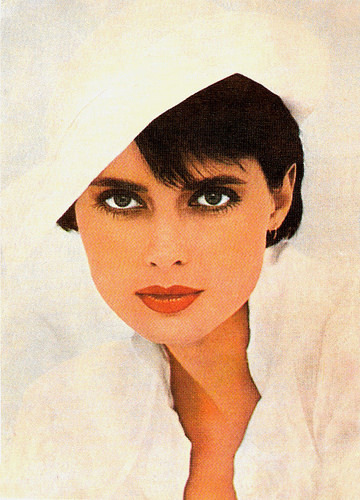
Romanian postcard by Casa Filmului Acin, C.P.C.S. Cda 43078.
Portrait of a Woman
Isabella Fiorella Elettra Giovanna Rossellini was born in Rome, Italy, in 1952. She was born cinema royalty as the daughter of Swedish-born, three-time Oscar-winning actress Ingrid Bergman and Italian director Roberto Rossellini. She has three siblings from her mother: her twin sister Isotta Ingrid Rossellini, who is an adjunct professor of Italian literature; a brother, Robertino Ingmar Rossellini; and a half-sister, Pia Lindström, who formerly worked on television and is from her mother's first marriage with Petter Lindström. She has four other siblings from her father's two other marriages: Romano (died at age nine), Renzo, Gil, and Raffaella.
Rossellini was raised in Rome, as well as in Santa Marinella and Paris. At 19, she went to New York, where she attended Finch College, while working as a translator and a RAI television reporter. She also appeared intermittently on L'altra Domenica (The Other Sunday), a TV show featuring Roberto Benigni .
Rossellini made her film debut with a brief appearance as a nun opposite her mother and Liza Minnelli in A Matter of Time (Vincente Minnelli, 1976). Her first leading role was in the film drama Il Prato/The Meadow (Paolo and Vittorio Taviani, 1979), opposite Michele Placido and Saverio Marconi. For this role Rossellini was awarded by the association of Italian film critics with a Nastro d'Argento (Silver Ribbon) for Best New Actress.
It was followed by a part in the comedy Il pap'occhio/In the Pope's Eye (Renzo Arbore, 1980) with Roberto Benigni and film director Martin Scorsese. The film was heavily attacked by the Catholic press. Three weeks later it was confiscated "for insulting the Catholic religion and the person of the Holy Pope". However, the film grossed 5 billion lire being the 5th best grossing film in Italy in the 1980/1981 season. In 1979, she had married Scorsese and went to live with him in New York. They divorced in 1982.
At the age of 28, her modelling career began, when she was photographed by Bruce Weber for British Vogue and by Bill King for American Vogue. During her career, she also worked with many other renowned photographers, including Richard Avedon, Steven Meisel, Helmut Newton, Francesco Scavullo, Annie Leibovitz, and Robert Mapplethorpe. Her image has appeared on such magazines as Marie Claire, Harper's Bazaar, Vanity Fair, and ELLE.
In March 1988, an exhibition dedicated to photographs of her, called Portrait of a Woman, was held at the Musee d'Art Moderne in Paris. Rossellini's modelling career led her into the world of cosmetics, when she became the exclusive spokes model for the cosmetics brand Lancôme in 1982. In 1996, when she was 44, she was removed as the face of Lancôme for being ‘too old.’ A year earlier, Rossellini had worked with the Coty Group and developed her own brand of cosmetics, Isabella Rossellini's Manifesto.
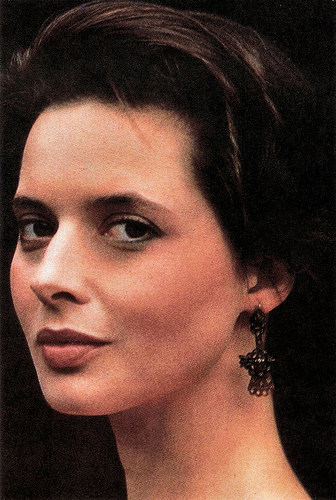
Chinese postcard.
Blue Velvet
Following her mother's death in 1982, Isabella Rossellini was cast in her first American film, the Cold War drama White Nights (Taylor Hackford, 1985), starring Mikhail Baryshnikov. This was followed by her notable role as the tortured nightclub singer Dorothy Vallens in David Lynch’s masterpiece Blue Velvet (1986), in which she also contributed her own singing. For this part she earned an Independent Spirit Award for Best Female Lead.
Other significant film roles during this period include her work in the comedy Cousins (Joel Schumacher, 1989), the crime thriller Wild at Heart (David Lynch, 1990), the black comedy fantasy Death Becomes Her (Robert Zemeckis, 1992) with Meryl Streep, Fearless (Peter Weir, 1993) with Jeff Bridges, and Immortal Beloved (Bernard Rose, 1994) about the life of composer Ludwig van Beethoven (played by Gary Oldman).
In 1992, Rossellini modelled for Madonna's controversial book Sex. She also appeared in Madonna's music video for her hit song Erotica (1992). In 1996, she appeared as herself in an episode of the TV series Friends called The One With Frank Jr. That same year, she was nominated for a Golden Globe for her performance in Crime of the Century (Mark Rydell, 1996), a dramatisation of the Lindbergh kidnapping.
In Europe, she made the Dutch drama Left Luggage (Jeroen Krabbé, 1998), and the multimedia project The Tulse Luper Suitcases (Peter Greenaway, 2003-2004). Rossellini was a recurring character on the television series Alias (2003) and she also appeared in the Canadian film The Saddest Music in the World (Guy Maddin, 2003). In 2004, she played the High Priestess Thar in the Sci-Fi Channel miniseries Legend of Earthsea (Robert Lieberman, 2004).
My Dad Is 100 Years Old (Guy Maddin, 2006) is a tribute that Rossellini created for her father. In the film, she played almost every role, including Federico Fellini, Alfred Hitchcock, and her mother Ingrid Bergman . In 2007, Rossellini guest starred on two episodes of the television show 30 Rock, playing Alec Baldwin's character's ex-wife.
Around the same time, Rossellini enrolled at Hunter College in New York, US to study Animal Behavior, and she made the series Green Porno (2008). The first series of Green Porno garnered over 4 million views on YouTube and two further seasons were produced. Rossellini was responsible for the scripts, helped to design the creatures, directed the episodes, and is the primary actor in the series. In each of the episodes she acts out the mating rituals and reproductive behaviour of various animals while commentary is concurrently played. Green Porno was followed by two other animal-themed television productions: Seduce Me: The Spawn of Green Porno (2010) and Mammas (2013).
Rossellini acted in the Canadian-Spanish psychological thriller Enemy (Denis Villeneuve, 2013), alongside Jake Gyllenhaal. She also played silent film actor Rudolph Valentino's mother in Silent Life (Vlad Kozlov, 2012). Rossellini has written three books: her self-described fictional memoir, Some of Me (1997), Looking at Me (on pictures and photographers, 2002), and In the name of the Father, the Daughter and the Holy Spirits: Remembering Roberto Rossellini (2006).
After her marriage to Martin Scorsese ended, Isabella Rossellini married Jon Wiedemann (1983–1986), a Harvard-educated and former fashion model from Texas (now a Microsoft design manager). Later, she dated David Lynch, Gary Oldman and Gregory Mosher. She has a daughter, Elettra Rossellini Wiedemann (1983) and a son, Roberto (1993). Rossellini holds dual Italian and United States citizenship.
Scene from Il Prato/The Meadow (Paolo and Vittorio Taviani, 1979). Source: Alexis Goussev (YouTube). Isabella Rossellini seeing her father's Germania anno zero (Roberto Rossellini, 1948).
Trailer for Blue Velvet (David Lynch, 1986). Source: Ageless Trailers (YouTube).
Trailer for Left Luggage (Jeroen Krabbé, 1998). Source: AngelTwo SkyAngelNetworks (YouTube).
Trailer Green Porno (Isanbella Rossellini, 2008). Source: septimoartecolombia (YouTube).
Sources: (IMDb), Wikipedia and .

Romanian postcard by Casa Filmului Acin, C.P.C.S. Cda 43078.
Portrait of a Woman
Isabella Fiorella Elettra Giovanna Rossellini was born in Rome, Italy, in 1952. She was born cinema royalty as the daughter of Swedish-born, three-time Oscar-winning actress Ingrid Bergman and Italian director Roberto Rossellini. She has three siblings from her mother: her twin sister Isotta Ingrid Rossellini, who is an adjunct professor of Italian literature; a brother, Robertino Ingmar Rossellini; and a half-sister, Pia Lindström, who formerly worked on television and is from her mother's first marriage with Petter Lindström. She has four other siblings from her father's two other marriages: Romano (died at age nine), Renzo, Gil, and Raffaella.
Rossellini was raised in Rome, as well as in Santa Marinella and Paris. At 19, she went to New York, where she attended Finch College, while working as a translator and a RAI television reporter. She also appeared intermittently on L'altra Domenica (The Other Sunday), a TV show featuring Roberto Benigni .
Rossellini made her film debut with a brief appearance as a nun opposite her mother and Liza Minnelli in A Matter of Time (Vincente Minnelli, 1976). Her first leading role was in the film drama Il Prato/The Meadow (Paolo and Vittorio Taviani, 1979), opposite Michele Placido and Saverio Marconi. For this role Rossellini was awarded by the association of Italian film critics with a Nastro d'Argento (Silver Ribbon) for Best New Actress.
It was followed by a part in the comedy Il pap'occhio/In the Pope's Eye (Renzo Arbore, 1980) with Roberto Benigni and film director Martin Scorsese. The film was heavily attacked by the Catholic press. Three weeks later it was confiscated "for insulting the Catholic religion and the person of the Holy Pope". However, the film grossed 5 billion lire being the 5th best grossing film in Italy in the 1980/1981 season. In 1979, she had married Scorsese and went to live with him in New York. They divorced in 1982.
At the age of 28, her modelling career began, when she was photographed by Bruce Weber for British Vogue and by Bill King for American Vogue. During her career, she also worked with many other renowned photographers, including Richard Avedon, Steven Meisel, Helmut Newton, Francesco Scavullo, Annie Leibovitz, and Robert Mapplethorpe. Her image has appeared on such magazines as Marie Claire, Harper's Bazaar, Vanity Fair, and ELLE.
In March 1988, an exhibition dedicated to photographs of her, called Portrait of a Woman, was held at the Musee d'Art Moderne in Paris. Rossellini's modelling career led her into the world of cosmetics, when she became the exclusive spokes model for the cosmetics brand Lancôme in 1982. In 1996, when she was 44, she was removed as the face of Lancôme for being ‘too old.’ A year earlier, Rossellini had worked with the Coty Group and developed her own brand of cosmetics, Isabella Rossellini's Manifesto.

Chinese postcard.
Blue Velvet
Following her mother's death in 1982, Isabella Rossellini was cast in her first American film, the Cold War drama White Nights (Taylor Hackford, 1985), starring Mikhail Baryshnikov. This was followed by her notable role as the tortured nightclub singer Dorothy Vallens in David Lynch’s masterpiece Blue Velvet (1986), in which she also contributed her own singing. For this part she earned an Independent Spirit Award for Best Female Lead.
Other significant film roles during this period include her work in the comedy Cousins (Joel Schumacher, 1989), the crime thriller Wild at Heart (David Lynch, 1990), the black comedy fantasy Death Becomes Her (Robert Zemeckis, 1992) with Meryl Streep, Fearless (Peter Weir, 1993) with Jeff Bridges, and Immortal Beloved (Bernard Rose, 1994) about the life of composer Ludwig van Beethoven (played by Gary Oldman).
In 1992, Rossellini modelled for Madonna's controversial book Sex. She also appeared in Madonna's music video for her hit song Erotica (1992). In 1996, she appeared as herself in an episode of the TV series Friends called The One With Frank Jr. That same year, she was nominated for a Golden Globe for her performance in Crime of the Century (Mark Rydell, 1996), a dramatisation of the Lindbergh kidnapping.
In Europe, she made the Dutch drama Left Luggage (Jeroen Krabbé, 1998), and the multimedia project The Tulse Luper Suitcases (Peter Greenaway, 2003-2004). Rossellini was a recurring character on the television series Alias (2003) and she also appeared in the Canadian film The Saddest Music in the World (Guy Maddin, 2003). In 2004, she played the High Priestess Thar in the Sci-Fi Channel miniseries Legend of Earthsea (Robert Lieberman, 2004).
My Dad Is 100 Years Old (Guy Maddin, 2006) is a tribute that Rossellini created for her father. In the film, she played almost every role, including Federico Fellini, Alfred Hitchcock, and her mother Ingrid Bergman . In 2007, Rossellini guest starred on two episodes of the television show 30 Rock, playing Alec Baldwin's character's ex-wife.
Around the same time, Rossellini enrolled at Hunter College in New York, US to study Animal Behavior, and she made the series Green Porno (2008). The first series of Green Porno garnered over 4 million views on YouTube and two further seasons were produced. Rossellini was responsible for the scripts, helped to design the creatures, directed the episodes, and is the primary actor in the series. In each of the episodes she acts out the mating rituals and reproductive behaviour of various animals while commentary is concurrently played. Green Porno was followed by two other animal-themed television productions: Seduce Me: The Spawn of Green Porno (2010) and Mammas (2013).
Rossellini acted in the Canadian-Spanish psychological thriller Enemy (Denis Villeneuve, 2013), alongside Jake Gyllenhaal. She also played silent film actor Rudolph Valentino's mother in Silent Life (Vlad Kozlov, 2012). Rossellini has written three books: her self-described fictional memoir, Some of Me (1997), Looking at Me (on pictures and photographers, 2002), and In the name of the Father, the Daughter and the Holy Spirits: Remembering Roberto Rossellini (2006).
After her marriage to Martin Scorsese ended, Isabella Rossellini married Jon Wiedemann (1983–1986), a Harvard-educated and former fashion model from Texas (now a Microsoft design manager). Later, she dated David Lynch, Gary Oldman and Gregory Mosher. She has a daughter, Elettra Rossellini Wiedemann (1983) and a son, Roberto (1993). Rossellini holds dual Italian and United States citizenship.
Scene from Il Prato/The Meadow (Paolo and Vittorio Taviani, 1979). Source: Alexis Goussev (YouTube). Isabella Rossellini seeing her father's Germania anno zero (Roberto Rossellini, 1948).
Trailer for Blue Velvet (David Lynch, 1986). Source: Ageless Trailers (YouTube).
Trailer for Left Luggage (Jeroen Krabbé, 1998). Source: AngelTwo SkyAngelNetworks (YouTube).
Trailer Green Porno (Isanbella Rossellini, 2008). Source: septimoartecolombia (YouTube).
Sources: (IMDb), Wikipedia and .
Published on January 31, 2016 22:00
January 30, 2016
Léon Bernard
French stage actor Léon Bernard (1877-1935) was a Sociétaire of the noted Comédie-Française. Before, during and after the First World War, he also appeared in dozens of silent films, including Les misérables (Albert Capellani, 1912). Bernard also worked as a theatre director.
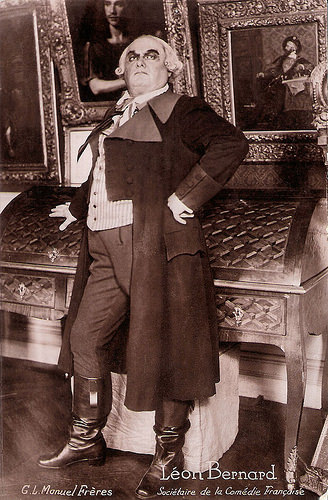
French postcard. Photo: G.L. Manuel Frères. Caption: Sociétaire de la Comédie Française.
The Comédie-Française is the only state theatre in France to have its own troupe of actors. The membership of the theatrical troupe is divided into 'sociétaires' and 'pensionnaires.' The former are regular members of the organisation and as such receive a pension after 20 years of service, while the latter are paid actors who may, after a certain length of service, become 'sociétaires.'
The 354th sociétaire of the Comédie-Française
Léon-Constant-Jean Bernard was born in Paris in 1877. After his debut as stage actor in local theatres, he contributed as Raynouard to the creation of Madame Sans-Gêne by Victorien Sardou and Émile Moreau, which premiered in 1893 at the Théâtre du Vaudeville in Paris.
He then joined the company of the Théâtre-Libre by André Antoine under whose direction he acted in e.g. King Lear by William Shakespeare, Les Avariés by Eugène Brieux, Ghosts by Henrik Ibsen and The Power of Darkness by Leo Tolstoy at the Théâtre Antoine. After that he was in Julius Caesar by Shakespeare, Ramuntcho by Pierre Loti, Beethoven by René Fauchois and La Maison des juges by Gaston Leroux at the Odéon where Antoine had taken up direction in 1906.
In 1910 he debuted at the Comédie-Française in Les Romanesques by Edmond Rostand. He was appointed as the 354th sociétaire in 1914 and entered the reading committee in 1925. In the same year he als became teacher of declamation at the Paris Conservatory, where he had not been accepted as pupil by the way. Bernard was appointed officer in the Legion of Honour in 1934. He was also chair of the Association des artistes dramatiques and of the home of Couilly-Pont-aux-Dames.
In 1911 Léon Bernard debuted as actor in French silent film, probably in the short Pathé production Madame Tallien (Camille de Morlhon, 1911), based on Victorien Sardou’s play and starring Berthe Bovy. In the early 1910s he had a fertile screen acting career at Pathé, in particular under the direction of Albert Capellani. He acted in many short historical and modern dramas by Capellani, such as Anna Karénine (1912), Manon Lescaut (1912), and Le nabab (1913), as bishop Myriel.
Bernard also played in Capellani’s major four part series film Les misérables (Albert Capellani, 1912), adapted from Victor Hugo, and starring Henry Krauss as Jean Valjean and Henri Étievant as Javert. That same year he appeared in Capellani’s feature Les mystères de Paris/The Mysteries of Paris (Albert Capellani, 1912), based on Eugène Sue’s novel and starring Paul Capellani . He also could be seen in several shorts by other directors such as Georges Monca, Henri Desfontaines, Adrien Caillard, and Henri Maillard.
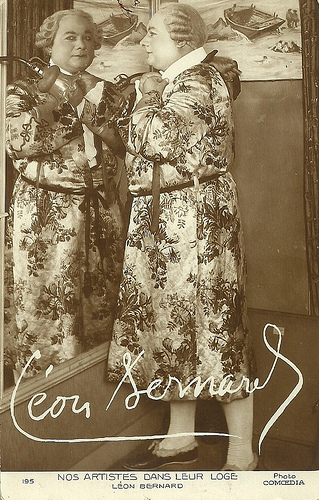
French postcard in the Nos artistes dans leur loge series, no. 195. Photo: Comoedia.
Daddy Good-Heart
During the First World War, Léon Bernard acted in propaganda films such as Patrie/Fatherland (Albert Capellani, 1914), starring Henry Krauss and Paul Capellani , L’auréole de la gloire/Aureole of Glory (Georges Monca, 1915) in which he had the lead, Les petits soldats de plomb/The Little Tin Soldiers (Pierre Bressol, 1916), and Noël de guerre/Wartime Christmas (Félicien Champsaur, 1916), again starring Bernard.
In the war years Bernard also played leads as father Frantz in Capellani’s Éternel amour/Eternal Love (Albert Capellani, 1914), as Bernard Desormes in Les feuilles tombent/The Leaves Are Falling (Georges Monca, 1917), as the ‘poilu’ in Le petit chaperon rose/The Little Pink Hood (Maurice Poggi, 1917), and important supporting parts in André Hugon’s Vertige/Vertigo (1917) with André Nox, and the court case film Le coupable/The Guilty One (André Antoine, 1917) starring Romuald Joubé .
In the 1920s, Bernard had the lead as the title character in Papa Bon Coeur/Daddy Good-Heart (Jacques Grétillat, 1921). Bernard is an orchestra leader at the Opera who degrades to musician at a cinema. His wife (Jeanne Bucy) has run off with their daughter to a count (Pierre Magnier), whose wife dies under suspect circumstances. Ten years after the daughter (Yvonne Sergyl) suspects the countess is murdered and meets her real father. Together with the daughter’s boyfriend (Emile Drain), Papa Bon Coeur unmasks the count as the murderer. Apparently Pierre Blanchar had his first film part in this film.
After Papa Bon Coeur Bernard had supporting parts in e.g. Hantise/Obsession (Jean Kemm, 1922) with Geneviève Félix and Gaston Jacquet, and Le loup-garou/The Werewolf (Pierre Bressol, Jacques Roullet, 1924) with Pierre Bressol and Madeleine Guitty. However, from the mid-1920s he didn’t act in silent cinema anymore.
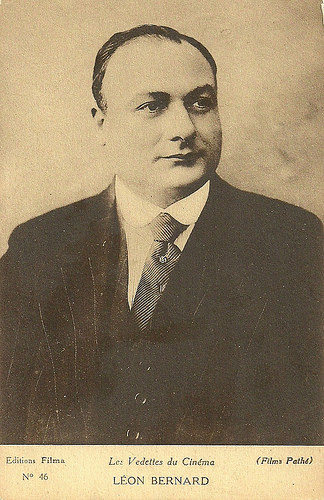
French postcard by Editions Filma in the Les Vedettes du Cinéma series, no. 46. Photo: Films Pathé.
The Son-in-law of Mr. Poirier
Years later, after sound cinema had arrived in France, Léon Bernard returned to the set for two last films. First he had he lead as Mr. Poirier in Marcel Pagnol’s Le gendre de Monsieur Poirier/The son-in-law of Mr. Poirier(1933), based on a play by Émile Augier and scripted by Pagnol himself.
During the reign of Louis-Philippe, Gaston de Presles (Jean Debucourt), the son-in-law of the rich bourgeois Mr. Poirier (Bernard), is a spoiled aristocrat, who has married to solve his debts. In the meanwhile the businessman Poirier hopes he can buy the title of ‘pair de France’. Gaston and Poirier constantly fight each other. In the end Gaston decides to change his life and dedicate himself to his wife ( Annie Decaux ) and his work.
Bernard’s last film part was again a lead, this time in the adaptation of Sacha Guitry ’s comedy Les deux couverts/Table for two (Léonce Perret, 1935).
In anticipation of the success of his bachelor son Jacques (Robert Scipion), Mr. Pelletier is preparing a late dinner that the two men will taste face to face. The arrival of Mrs. Blandin (Gabrielle Robinne), mistress of Mr. Pelletier, complicates things, but he manages to turn her away kindly. Jacques finally arrives. He missed his examination and tension rises between father and son. Bitter and resigned, Pelletier sits alone at the table.
At the age of 58, Léon Bernard died of sepsis after a whitlow in 1935. He lies buried in the cemetery of Montparnasse.
Le gendre de Monsieur Poirier (1933). Source: Christo Fulster (YouTube). Sorry, with scarce and often incorrect English subtitles.
Sources: Ciné-Ressources (French), Wikipedia (French) and .

French postcard. Photo: G.L. Manuel Frères. Caption: Sociétaire de la Comédie Française.
The Comédie-Française is the only state theatre in France to have its own troupe of actors. The membership of the theatrical troupe is divided into 'sociétaires' and 'pensionnaires.' The former are regular members of the organisation and as such receive a pension after 20 years of service, while the latter are paid actors who may, after a certain length of service, become 'sociétaires.'
The 354th sociétaire of the Comédie-Française
Léon-Constant-Jean Bernard was born in Paris in 1877. After his debut as stage actor in local theatres, he contributed as Raynouard to the creation of Madame Sans-Gêne by Victorien Sardou and Émile Moreau, which premiered in 1893 at the Théâtre du Vaudeville in Paris.
He then joined the company of the Théâtre-Libre by André Antoine under whose direction he acted in e.g. King Lear by William Shakespeare, Les Avariés by Eugène Brieux, Ghosts by Henrik Ibsen and The Power of Darkness by Leo Tolstoy at the Théâtre Antoine. After that he was in Julius Caesar by Shakespeare, Ramuntcho by Pierre Loti, Beethoven by René Fauchois and La Maison des juges by Gaston Leroux at the Odéon where Antoine had taken up direction in 1906.
In 1910 he debuted at the Comédie-Française in Les Romanesques by Edmond Rostand. He was appointed as the 354th sociétaire in 1914 and entered the reading committee in 1925. In the same year he als became teacher of declamation at the Paris Conservatory, where he had not been accepted as pupil by the way. Bernard was appointed officer in the Legion of Honour in 1934. He was also chair of the Association des artistes dramatiques and of the home of Couilly-Pont-aux-Dames.
In 1911 Léon Bernard debuted as actor in French silent film, probably in the short Pathé production Madame Tallien (Camille de Morlhon, 1911), based on Victorien Sardou’s play and starring Berthe Bovy. In the early 1910s he had a fertile screen acting career at Pathé, in particular under the direction of Albert Capellani. He acted in many short historical and modern dramas by Capellani, such as Anna Karénine (1912), Manon Lescaut (1912), and Le nabab (1913), as bishop Myriel.
Bernard also played in Capellani’s major four part series film Les misérables (Albert Capellani, 1912), adapted from Victor Hugo, and starring Henry Krauss as Jean Valjean and Henri Étievant as Javert. That same year he appeared in Capellani’s feature Les mystères de Paris/The Mysteries of Paris (Albert Capellani, 1912), based on Eugène Sue’s novel and starring Paul Capellani . He also could be seen in several shorts by other directors such as Georges Monca, Henri Desfontaines, Adrien Caillard, and Henri Maillard.

French postcard in the Nos artistes dans leur loge series, no. 195. Photo: Comoedia.
Daddy Good-Heart
During the First World War, Léon Bernard acted in propaganda films such as Patrie/Fatherland (Albert Capellani, 1914), starring Henry Krauss and Paul Capellani , L’auréole de la gloire/Aureole of Glory (Georges Monca, 1915) in which he had the lead, Les petits soldats de plomb/The Little Tin Soldiers (Pierre Bressol, 1916), and Noël de guerre/Wartime Christmas (Félicien Champsaur, 1916), again starring Bernard.
In the war years Bernard also played leads as father Frantz in Capellani’s Éternel amour/Eternal Love (Albert Capellani, 1914), as Bernard Desormes in Les feuilles tombent/The Leaves Are Falling (Georges Monca, 1917), as the ‘poilu’ in Le petit chaperon rose/The Little Pink Hood (Maurice Poggi, 1917), and important supporting parts in André Hugon’s Vertige/Vertigo (1917) with André Nox, and the court case film Le coupable/The Guilty One (André Antoine, 1917) starring Romuald Joubé .
In the 1920s, Bernard had the lead as the title character in Papa Bon Coeur/Daddy Good-Heart (Jacques Grétillat, 1921). Bernard is an orchestra leader at the Opera who degrades to musician at a cinema. His wife (Jeanne Bucy) has run off with their daughter to a count (Pierre Magnier), whose wife dies under suspect circumstances. Ten years after the daughter (Yvonne Sergyl) suspects the countess is murdered and meets her real father. Together with the daughter’s boyfriend (Emile Drain), Papa Bon Coeur unmasks the count as the murderer. Apparently Pierre Blanchar had his first film part in this film.
After Papa Bon Coeur Bernard had supporting parts in e.g. Hantise/Obsession (Jean Kemm, 1922) with Geneviève Félix and Gaston Jacquet, and Le loup-garou/The Werewolf (Pierre Bressol, Jacques Roullet, 1924) with Pierre Bressol and Madeleine Guitty. However, from the mid-1920s he didn’t act in silent cinema anymore.

French postcard by Editions Filma in the Les Vedettes du Cinéma series, no. 46. Photo: Films Pathé.
The Son-in-law of Mr. Poirier
Years later, after sound cinema had arrived in France, Léon Bernard returned to the set for two last films. First he had he lead as Mr. Poirier in Marcel Pagnol’s Le gendre de Monsieur Poirier/The son-in-law of Mr. Poirier(1933), based on a play by Émile Augier and scripted by Pagnol himself.
During the reign of Louis-Philippe, Gaston de Presles (Jean Debucourt), the son-in-law of the rich bourgeois Mr. Poirier (Bernard), is a spoiled aristocrat, who has married to solve his debts. In the meanwhile the businessman Poirier hopes he can buy the title of ‘pair de France’. Gaston and Poirier constantly fight each other. In the end Gaston decides to change his life and dedicate himself to his wife ( Annie Decaux ) and his work.
Bernard’s last film part was again a lead, this time in the adaptation of Sacha Guitry ’s comedy Les deux couverts/Table for two (Léonce Perret, 1935).
In anticipation of the success of his bachelor son Jacques (Robert Scipion), Mr. Pelletier is preparing a late dinner that the two men will taste face to face. The arrival of Mrs. Blandin (Gabrielle Robinne), mistress of Mr. Pelletier, complicates things, but he manages to turn her away kindly. Jacques finally arrives. He missed his examination and tension rises between father and son. Bitter and resigned, Pelletier sits alone at the table.
At the age of 58, Léon Bernard died of sepsis after a whitlow in 1935. He lies buried in the cemetery of Montparnasse.
Le gendre de Monsieur Poirier (1933). Source: Christo Fulster (YouTube). Sorry, with scarce and often incorrect English subtitles.
Sources: Ciné-Ressources (French), Wikipedia (French) and .
Published on January 30, 2016 22:00
January 29, 2016
Karin Molander
Swedish actress Karin Molander (1889–1978) was a star of the silent Scandinavian cinema. In the films of Mauritz Stiller, she became a symbol of the modern, young and emancipated women of the 1910s.
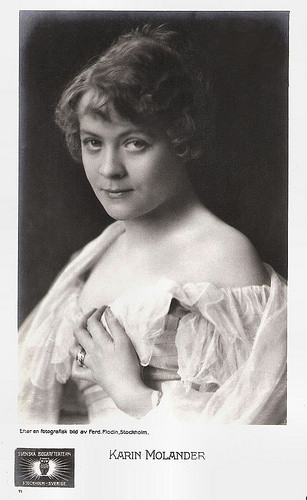
Swedish postcard by Svenska Biografteatern, Stockholm, no. 71. Photo: Ferd. Flodin, Stockholm.
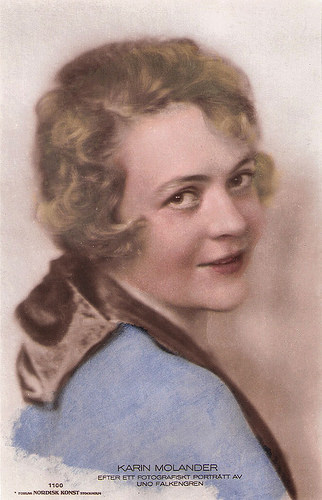
Swedish postcard by Förlag Nordisk Konst, Stockholm, no. 1100. After a portrait by Uno Falkengren.
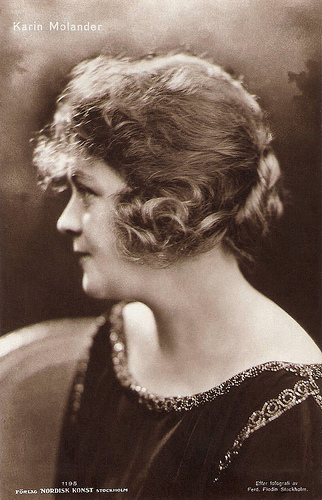
Swedish postcard by Förlag Nordisk Konst, Stockholm, no. 1195. Photo: Ferd. Flodin, Stockholm.
Victor Sjöström
Karin Molander was born as Katarina Margareta Elisabet Edwertz in Vårdinge, Sweden in 1889. She had acting classes from Julia Håkansson. In 1907 she made her stage debut at the Vasateatern in Stockholm.
For a period she worked in Helsinki, Finland, where she met actor Gustav Molander who would later become a well-known film director and screenwriter. He wrote several screenplays for Victor Sjöström and Mauritz Stiller, and was helped by the latter to get employment as a director for Svensk Filmindustri and would later direct Intermezzo (1936), which became Ingrid Bergman 's breakthrough and paved her way to America.
Karin and Gustav married in 1910 and returned to Sweden. She was engaged at the Intiman (Intimate theatre) (1911-1920), and hesitantly, she made her film debut in Victor Sjöström 's Halvblod/Half-Breed (1913).
Molander found film work more interesting and rewarding than she had expected, and she became one of the leading actors of director Mauritz Stiller. She appeared in his films Det röda tornet/The Red Tower (Mauritz Stiller, 1914), Hämnaren/The Avenger (Mauritz Stiller, 1915), Kärlek och journalistik/Love and Journalism (Mauritz Stiller, 1916), Tomas Graals basta film/Thomas Graal’s Best Film (Mauritz Stiller, 1917) and Thomas Graals bästa barn/Marriage a la Mode (Mauritz Stiller, 1917).
In the delightful comedy Tomas Graals basta film, Victor Sjöström plays a screenwriter, struggling to cope with the trials and tribulations of everyday life. Sjöström’s effort to succeed in the film industry are complicated by his romance with a rich man’s daughter (Karin Molander). At AllMovie , Hal Erickson writes: “Though the plot is pure sitcom fluff, Thomas Graal’s Best Film offers a tantalizing behind-the-scenes glimpse of Swedish film-making techniques, vintage 1917.”
With her healthy and relaxed playing style Karin Molander became a symbol of the modern, young and emancipated women. Later, she made more dramatic film roles as the title character in Synnøve Solbakken (John W. Brunius, 1919) opposite Lars Hanson , with whom she fell in love. The couple went on tour together and in 1919 Karin divorced from Gustav Molander.
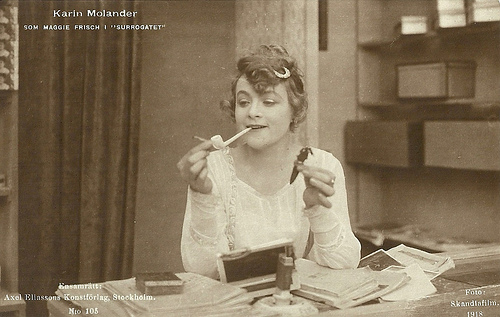
Swedish postcard by Axel Eliassons Konstförlag, Stockholm, no. 105. Photo: Skandiafilm, 1918. Karin Molander in Surrogatet (Einar Bruun, 1918-1919).
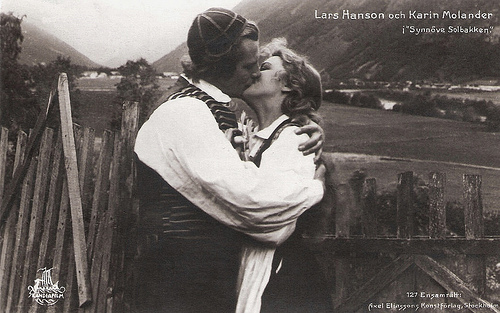
Swedish postcard by Axel Eliassons Konstförlag, Stockholm, no. 127. Photo: Skandiafilm. Still for Synnöva Solbakken (John W. Brunius, 1919) with Lars Hanson . Sent by mail in Norway in 1920.
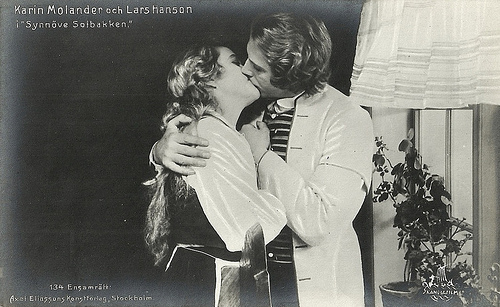
Swedish postcard by Axel Eliassons Konstförlag, Stockholm, no. 134. Photo: Skandia-Film. Publicity still for Synnöve Solbakken (John W. Brunius, 1919), starring Lars Hanson and Karen Molander, and adapted from Bjørnstjerne Bjørnson's Norwegian homonymous novel (1857).
Mauritz Stiller
Karin Molander’s last film with Stiller became a classic: Erotikon/Bonds That Chafe (Mauritz Stiller, 1920). By 1920 the artistic achievements of the Swedish cinema and its main directors, Victor Sjöström and Mauritz Stiller, were universally recognized. Most of their films reflected the life of rural Sweden. Stiller, a cultured man, decided to make a film set in a sophisticated urban milieu, Erotikon.
The story is about a professor of entomology (Anders de Wahl) who is sustained in his work by his devoted niece (Karin Molander) while his neglected wife seeks consolation elsewhere. Stiller built elaborate sets and commissioned a special exotic ballet for the theatre scenes which were shot in the Royal Opera House of Stockholm, with a host of society extras for an audience. The film reflected the fashionable life of the city and a modernity indicated by the inclusion of scenes with airplanes.
At Film Reference , Liam O’Leary writes: “It is handled with the lightest of touches; the irony of the scene where the man who tries to reconcile the married pair becomes the wife's lover is reminiscent of Ernst Lubitsch . Stiller's stylish direction works well with his talented players. Tore Teje's delightful portrayal of the wife is witty, wise and worldly. It is in striking contrast with the peasant role she had played the previous year in Sjöström's Karin Ingmarsdotter. Karin Molander's charming performance as the young niece is equally effective.”
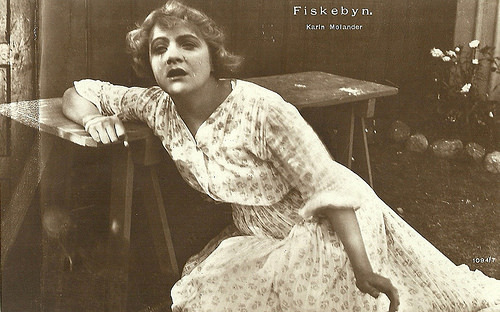
Swedish postcard by Förlag Nordisk Konst, Stockholm, no. 1094/7. Photo: Svenska Biografteatern. Karin Molander in Fiskebyn/The Fishing Village/Chains (Mauritz Stiller, 1920).
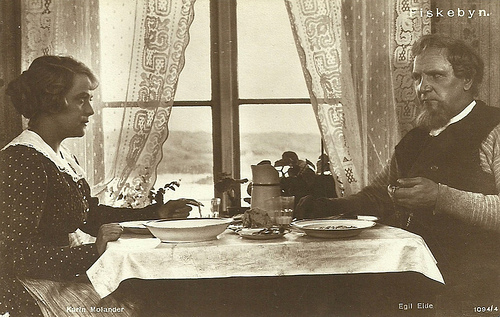
Swedish postcard by Förlag Nordisk Konst, Stockholm, no. 1094/4. Photo: Svenska Biografteatern. Karin Molander in Fiskebyn/The Fishing Village/Chains (Mauritz Stiller, 1920) with Egil Eide.
Lars Hanson
Erotikon helped to create a new genre of social comedy, and attracted considerable attention in the film world. However, it did not do anything for Karin Molander’s film career.
She played successfully on stage and married Lars Hanson in 1922. The newly wedded couple were regarded as superstars by theatre audiences. Molander made a guest appearance at the Lorensbergsteatern (Lorensbergs-Theatre) (1920-1922) and at the Kungliga Dramatiska Teatern (Royal Dramatic Theatre) (1922-1925).
For a few years at the end of the 1920s, she was inactive as an actress. She had followed her husband to Hollywood, where he starred opposite Lillian Gish in the silent classics The Scarlet Letter (1926) and The Wind (1928). On the net are pictures of Molander and Hansen in Hollywood, picknicking with Mauritz Stiller and Greta Garbo .
Back in Sweden Molander was engaged at the Royal Dramatic Theatre between 1931 and 1936, and after that she retired. In 1934 she had been awarded with the Royal Medal Litteris et artibus. Years later, she returned from her retirement once to play a supporting part in the film Gabrielle (Hasse Ekman, 1954).
Karin Molander and Lars Hanson stayed together until his death in 1965. Molander died in 1978 in Täby, Sweden. She was 89. She was survived by her son, actor-producer Harold Molander.
Scene from Synnöva Solbakken (1919). Source: Norskfilminstitutt (YouTube).
Sources: Liam O'Leary (Film Reference), Hal Erickson (AllMovie), Svenska Filminsitutet (Swedish), Wikipedia (Swedish) and .

Swedish postcard by Svenska Biografteatern, Stockholm, no. 71. Photo: Ferd. Flodin, Stockholm.

Swedish postcard by Förlag Nordisk Konst, Stockholm, no. 1100. After a portrait by Uno Falkengren.

Swedish postcard by Förlag Nordisk Konst, Stockholm, no. 1195. Photo: Ferd. Flodin, Stockholm.
Victor Sjöström
Karin Molander was born as Katarina Margareta Elisabet Edwertz in Vårdinge, Sweden in 1889. She had acting classes from Julia Håkansson. In 1907 she made her stage debut at the Vasateatern in Stockholm.
For a period she worked in Helsinki, Finland, where she met actor Gustav Molander who would later become a well-known film director and screenwriter. He wrote several screenplays for Victor Sjöström and Mauritz Stiller, and was helped by the latter to get employment as a director for Svensk Filmindustri and would later direct Intermezzo (1936), which became Ingrid Bergman 's breakthrough and paved her way to America.
Karin and Gustav married in 1910 and returned to Sweden. She was engaged at the Intiman (Intimate theatre) (1911-1920), and hesitantly, she made her film debut in Victor Sjöström 's Halvblod/Half-Breed (1913).
Molander found film work more interesting and rewarding than she had expected, and she became one of the leading actors of director Mauritz Stiller. She appeared in his films Det röda tornet/The Red Tower (Mauritz Stiller, 1914), Hämnaren/The Avenger (Mauritz Stiller, 1915), Kärlek och journalistik/Love and Journalism (Mauritz Stiller, 1916), Tomas Graals basta film/Thomas Graal’s Best Film (Mauritz Stiller, 1917) and Thomas Graals bästa barn/Marriage a la Mode (Mauritz Stiller, 1917).
In the delightful comedy Tomas Graals basta film, Victor Sjöström plays a screenwriter, struggling to cope with the trials and tribulations of everyday life. Sjöström’s effort to succeed in the film industry are complicated by his romance with a rich man’s daughter (Karin Molander). At AllMovie , Hal Erickson writes: “Though the plot is pure sitcom fluff, Thomas Graal’s Best Film offers a tantalizing behind-the-scenes glimpse of Swedish film-making techniques, vintage 1917.”
With her healthy and relaxed playing style Karin Molander became a symbol of the modern, young and emancipated women. Later, she made more dramatic film roles as the title character in Synnøve Solbakken (John W. Brunius, 1919) opposite Lars Hanson , with whom she fell in love. The couple went on tour together and in 1919 Karin divorced from Gustav Molander.

Swedish postcard by Axel Eliassons Konstförlag, Stockholm, no. 105. Photo: Skandiafilm, 1918. Karin Molander in Surrogatet (Einar Bruun, 1918-1919).

Swedish postcard by Axel Eliassons Konstförlag, Stockholm, no. 127. Photo: Skandiafilm. Still for Synnöva Solbakken (John W. Brunius, 1919) with Lars Hanson . Sent by mail in Norway in 1920.

Swedish postcard by Axel Eliassons Konstförlag, Stockholm, no. 134. Photo: Skandia-Film. Publicity still for Synnöve Solbakken (John W. Brunius, 1919), starring Lars Hanson and Karen Molander, and adapted from Bjørnstjerne Bjørnson's Norwegian homonymous novel (1857).
Mauritz Stiller
Karin Molander’s last film with Stiller became a classic: Erotikon/Bonds That Chafe (Mauritz Stiller, 1920). By 1920 the artistic achievements of the Swedish cinema and its main directors, Victor Sjöström and Mauritz Stiller, were universally recognized. Most of their films reflected the life of rural Sweden. Stiller, a cultured man, decided to make a film set in a sophisticated urban milieu, Erotikon.
The story is about a professor of entomology (Anders de Wahl) who is sustained in his work by his devoted niece (Karin Molander) while his neglected wife seeks consolation elsewhere. Stiller built elaborate sets and commissioned a special exotic ballet for the theatre scenes which were shot in the Royal Opera House of Stockholm, with a host of society extras for an audience. The film reflected the fashionable life of the city and a modernity indicated by the inclusion of scenes with airplanes.
At Film Reference , Liam O’Leary writes: “It is handled with the lightest of touches; the irony of the scene where the man who tries to reconcile the married pair becomes the wife's lover is reminiscent of Ernst Lubitsch . Stiller's stylish direction works well with his talented players. Tore Teje's delightful portrayal of the wife is witty, wise and worldly. It is in striking contrast with the peasant role she had played the previous year in Sjöström's Karin Ingmarsdotter. Karin Molander's charming performance as the young niece is equally effective.”

Swedish postcard by Förlag Nordisk Konst, Stockholm, no. 1094/7. Photo: Svenska Biografteatern. Karin Molander in Fiskebyn/The Fishing Village/Chains (Mauritz Stiller, 1920).

Swedish postcard by Förlag Nordisk Konst, Stockholm, no. 1094/4. Photo: Svenska Biografteatern. Karin Molander in Fiskebyn/The Fishing Village/Chains (Mauritz Stiller, 1920) with Egil Eide.
Lars Hanson
Erotikon helped to create a new genre of social comedy, and attracted considerable attention in the film world. However, it did not do anything for Karin Molander’s film career.
She played successfully on stage and married Lars Hanson in 1922. The newly wedded couple were regarded as superstars by theatre audiences. Molander made a guest appearance at the Lorensbergsteatern (Lorensbergs-Theatre) (1920-1922) and at the Kungliga Dramatiska Teatern (Royal Dramatic Theatre) (1922-1925).
For a few years at the end of the 1920s, she was inactive as an actress. She had followed her husband to Hollywood, where he starred opposite Lillian Gish in the silent classics The Scarlet Letter (1926) and The Wind (1928). On the net are pictures of Molander and Hansen in Hollywood, picknicking with Mauritz Stiller and Greta Garbo .
Back in Sweden Molander was engaged at the Royal Dramatic Theatre between 1931 and 1936, and after that she retired. In 1934 she had been awarded with the Royal Medal Litteris et artibus. Years later, she returned from her retirement once to play a supporting part in the film Gabrielle (Hasse Ekman, 1954).
Karin Molander and Lars Hanson stayed together until his death in 1965. Molander died in 1978 in Täby, Sweden. She was 89. She was survived by her son, actor-producer Harold Molander.
Scene from Synnöva Solbakken (1919). Source: Norskfilminstitutt (YouTube).
Sources: Liam O'Leary (Film Reference), Hal Erickson (AllMovie), Svenska Filminsitutet (Swedish), Wikipedia (Swedish) and .
Published on January 29, 2016 22:00
January 28, 2016
EFSP's Dazzling Dozen: Star Pin-ups - Beefcake
Last Friday, we presented twelve star pin-up postcards to make you smile. Sexy starlets, sweet bathing beauties and lovely love goddesses. But this is an emancipated blog that also loves some good old beefcake. So here are twelve dreamboats that made many hearts beat faster. And yes, these postcards also make you smile (and sometimes grue).
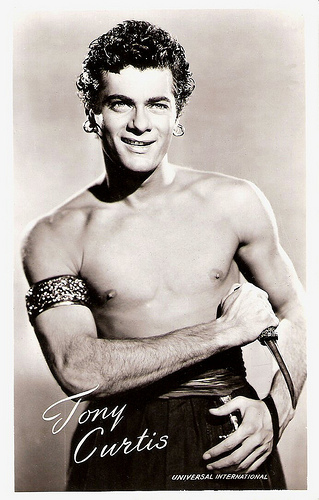
Dutch postcard by Uitg. Takken, no. 1578. Photo: Universal International.
American film actor Tony Curtis (1925-2010) played a variety of roles, from light comedy, such as the musician on the run from gangsters in Some Like It Hot, to serious dramatic roles, such as an escaped convict in The Defiant Ones, which earned him a nomination for the Academy Award for Best Actor. From 1949, he appeared in more than 100 films and made frequent television appearances.
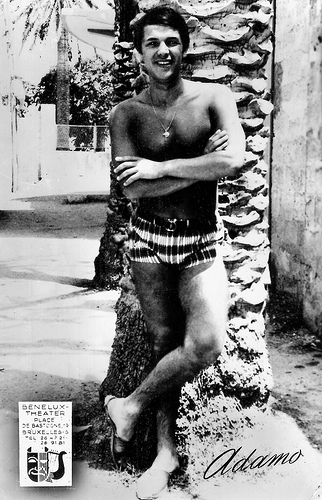
Dutch postcard by 't Sticht, Utrecht, no. 6829. Photo: Eddy Despretz.
Italian-Belgian composer and singer Salvatore Adamo (1943) was a teen idol in the first half of the 1960s, and occasionally, he also starred in films.
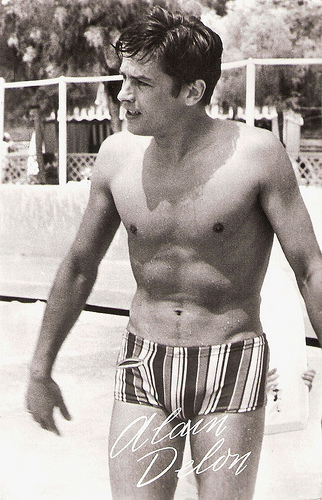
Dutch postcard by 't Sticht, Utrecht, no. 6176.
In the late 1950s and early 1960s Alain Delon (1935) was the breathtakingly good-looking James Dean of the French cinema.
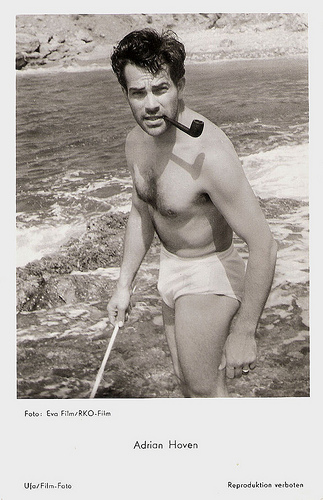
German postcard by Ufa, Berlin-Tempelhof, no. FK 1888. Photo: Eva-Film / RKO-Film. Publicity still for Solange Du Lebst/As Long as You Live (Harald Reinl, 1955).
Austrian actor Adrian Hoven (1922-1981) was the athletic and dynamic Sonnyboy of the German cinema in the 1950s, who would become one of the stars of Rainer Werner Fassbinder's films in the 1970s. As a writer, producer and director he made horror and erotica with SM overtones.
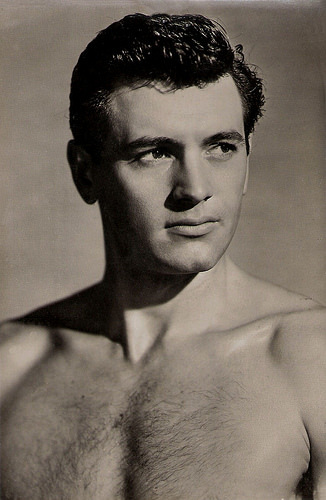
Spanish card, no. 5164. Photo: Arch. Bermejo.
Handsome American actor Rock Hudson (1925–1985) was a popular Hollywood star in the 1950s and 1960s. He was teamed up in romantic comedies with Doris Day, but he also starred in dramatic roles in Magnificent Obsession (1954) and Giant (1956).
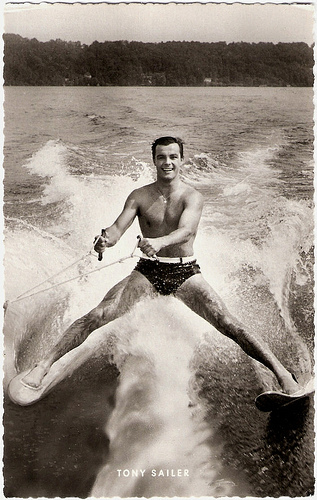
German postcard by Kunst und Bild, Berlin-Charlottenburg, no. B 1548. Photo: Centfox.
Charismatic multitalent Toni Sailer (1935-2009) was a legendary Austrian alpine ski racer, one of the best the sport has ever produced. The ‘Black Blitz from Kitz’ appeared as an actor and singer in several films and TV series. He was a national hero and matinee idol rolled into one.
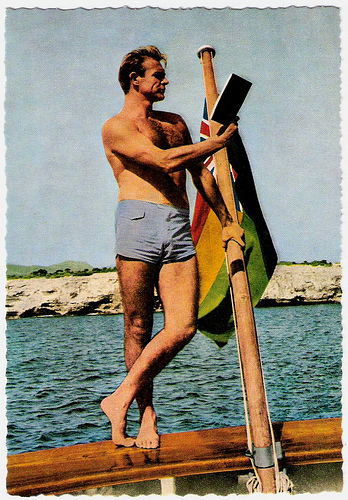
Vintage German postcard. Photo: P.A. Reuter. Publicity still for Thunderball (Terence Young, 1965).
Scottish superstar Sean Connery (1930) won an Academy Award, a Golden Globe and also a BAFTA Award. He is best known as the original secret agent 007, starring in seven James Bond films between 1962 and 1983.
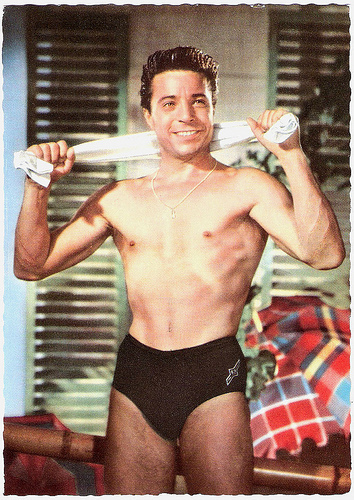
German postcard by Ufa (Universum-Film Aktiengesellschaft), Berlin-Tempelhof, no. CK-87. Retail price: 30 Pfg. Photo: Arthur Grimm / Ufa.
German actor Peter Garden (1924) was the ‘beautiful man’ in films of the Wirtschaftswunder era. Like his Hollywood equivalent Rock Hudson he posed for beefcake photos in swimming trousers.

Spanish postcard by Oscarcolor, no. 252. Photo: Warner Bros. Publicity still for the TV series Surfside 6 (1960-1962).
In 1959, Warner Brothers had a keen eye for photogenic hunks like Van Williams (1934) and smartly signed him. Fitting in perfectly, he was soon showing just how irresistible he was as a clean-cut private eye on the series Bourbon Street Beat (1959). Although the show lasted only one season, Warners carried his Kenny Madison character into the more popular adventure drama Surfside 6 (1960-1962).
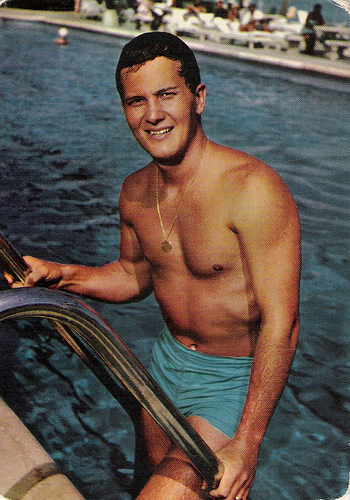
German postcard by Krüger, no. 902/64.
American singer and actor Pat Boone was a teen idol of the 1950s.
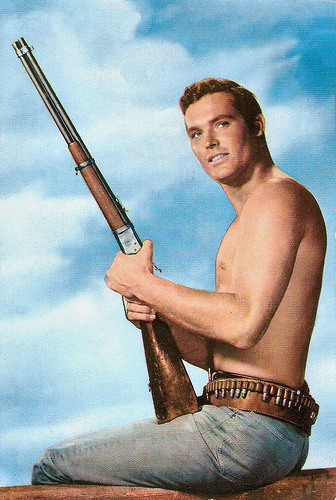
Spanish postcard by Ediciones Este, no. 7 T, 1963. Photo: Warner Bros. Publicity still for the TV series Bronco (1958-1962).
It's time to interrupt our pin-up series for some serious Hollywood beefcake. We start with Ty Hardin (1930), probably best known as TV cowboy Bronco.
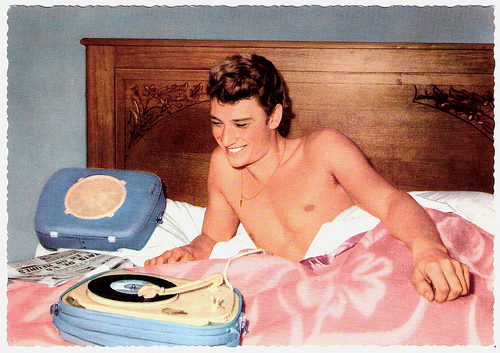
German postcard by Krüger, no. 902/307. Photo: Pierre Spitzer.
Flamboyant singer and actor Johnny Hallyday (1943) is the father of French Rock and Roll. He was a European teen idol in the 1960s with record-breaking crowds and mass hysteria, but he never became popular in the English-speaking market. In recent years he has concentrated on being an actor and appeared in more than 35 films.
This is a post for Postcard Friendship Friday, hosted by Beth at the The Best Hearts are Crunchy. You can visit her by clicking on the button below.


Dutch postcard by Uitg. Takken, no. 1578. Photo: Universal International.
American film actor Tony Curtis (1925-2010) played a variety of roles, from light comedy, such as the musician on the run from gangsters in Some Like It Hot, to serious dramatic roles, such as an escaped convict in The Defiant Ones, which earned him a nomination for the Academy Award for Best Actor. From 1949, he appeared in more than 100 films and made frequent television appearances.

Dutch postcard by 't Sticht, Utrecht, no. 6829. Photo: Eddy Despretz.
Italian-Belgian composer and singer Salvatore Adamo (1943) was a teen idol in the first half of the 1960s, and occasionally, he also starred in films.

Dutch postcard by 't Sticht, Utrecht, no. 6176.
In the late 1950s and early 1960s Alain Delon (1935) was the breathtakingly good-looking James Dean of the French cinema.

German postcard by Ufa, Berlin-Tempelhof, no. FK 1888. Photo: Eva-Film / RKO-Film. Publicity still for Solange Du Lebst/As Long as You Live (Harald Reinl, 1955).
Austrian actor Adrian Hoven (1922-1981) was the athletic and dynamic Sonnyboy of the German cinema in the 1950s, who would become one of the stars of Rainer Werner Fassbinder's films in the 1970s. As a writer, producer and director he made horror and erotica with SM overtones.

Spanish card, no. 5164. Photo: Arch. Bermejo.
Handsome American actor Rock Hudson (1925–1985) was a popular Hollywood star in the 1950s and 1960s. He was teamed up in romantic comedies with Doris Day, but he also starred in dramatic roles in Magnificent Obsession (1954) and Giant (1956).

German postcard by Kunst und Bild, Berlin-Charlottenburg, no. B 1548. Photo: Centfox.
Charismatic multitalent Toni Sailer (1935-2009) was a legendary Austrian alpine ski racer, one of the best the sport has ever produced. The ‘Black Blitz from Kitz’ appeared as an actor and singer in several films and TV series. He was a national hero and matinee idol rolled into one.

Vintage German postcard. Photo: P.A. Reuter. Publicity still for Thunderball (Terence Young, 1965).
Scottish superstar Sean Connery (1930) won an Academy Award, a Golden Globe and also a BAFTA Award. He is best known as the original secret agent 007, starring in seven James Bond films between 1962 and 1983.

German postcard by Ufa (Universum-Film Aktiengesellschaft), Berlin-Tempelhof, no. CK-87. Retail price: 30 Pfg. Photo: Arthur Grimm / Ufa.
German actor Peter Garden (1924) was the ‘beautiful man’ in films of the Wirtschaftswunder era. Like his Hollywood equivalent Rock Hudson he posed for beefcake photos in swimming trousers.

Spanish postcard by Oscarcolor, no. 252. Photo: Warner Bros. Publicity still for the TV series Surfside 6 (1960-1962).
In 1959, Warner Brothers had a keen eye for photogenic hunks like Van Williams (1934) and smartly signed him. Fitting in perfectly, he was soon showing just how irresistible he was as a clean-cut private eye on the series Bourbon Street Beat (1959). Although the show lasted only one season, Warners carried his Kenny Madison character into the more popular adventure drama Surfside 6 (1960-1962).

German postcard by Krüger, no. 902/64.
American singer and actor Pat Boone was a teen idol of the 1950s.

Spanish postcard by Ediciones Este, no. 7 T, 1963. Photo: Warner Bros. Publicity still for the TV series Bronco (1958-1962).
It's time to interrupt our pin-up series for some serious Hollywood beefcake. We start with Ty Hardin (1930), probably best known as TV cowboy Bronco.

German postcard by Krüger, no. 902/307. Photo: Pierre Spitzer.
Flamboyant singer and actor Johnny Hallyday (1943) is the father of French Rock and Roll. He was a European teen idol in the 1960s with record-breaking crowds and mass hysteria, but he never became popular in the English-speaking market. In recent years he has concentrated on being an actor and appeared in more than 35 films.
This is a post for Postcard Friendship Friday, hosted by Beth at the The Best Hearts are Crunchy. You can visit her by clicking on the button below.

Published on January 28, 2016 22:00
January 27, 2016
Claude Rains
The career of English stage and film actor Claude Rains (1889 - 1967) spanned 47 years. In Hollywood he was a supporting actor who achieved A-list stardom. With his smooth distinguished voice he could portray a wide variety of roles, ranging from villains to sympathetic gentlemen. He is best known as the title figure in The Invisible Man (1933), as wicked Prince John in The Adventures of Robin Hood (1938), as a corrupt senator in Mr. Smith Goes to Washington (1939), and, of course, as Captain Renault in Casablanca (1942).
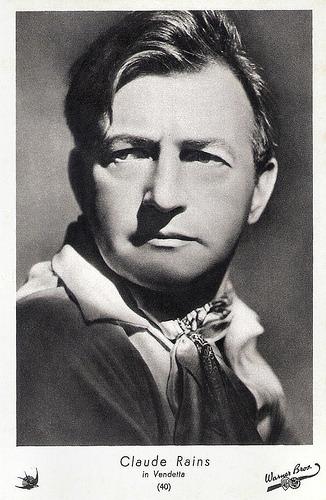
Italian postcard in the Artisti del Cinema Series, no. 100, by Edizione ELAH, La vasa delle Caramelle. Photo: Warner Bros. Publicity still for They Won't Forget (Mervyn LeRoy, 1937).
Gas Attack
William Claude Rains was born in Camberwell, London in 1889. In 2008, his daughter Jessica Rains and David J. Skal would publish the biography Claude Rains: An Actor's Voice. According to Jessica, he grew up, with "a very serious cockney accent and a speech impediment". His father was English stage actor and later film director Frederick Rains.
In 1900, the 11 year-old Rains made his stage debut as a boy singer in Sweet Nell of Old Drury. He learned the technical end of the business by working his way up from being a two-dollars-a-week page boy to assistant stage manager at His Majesty's Theatre in London. In 1911, he made his adult stage debut in Gods of the Mountains.
His acting talents were recognised by Sir Herbert Beerbohm Tree, founder of The Royal Academy of Dramatic Art. Tree paid for the elocution lessons Rains needed in order to succeed as an actor. After making his American stage debut in tour with Granville Barker's troupe in Androcles and the Lion, Rains returned to England.
He served in the First World War in the London Scottish Regiment, with fellow actors Basil Rathbone, Ronald Colman and Herbert Marshall . Rains was involved in a gas attack that left him nearly blind in one eye for the rest of his life. However, the war did aid his social advancement and, by its end, he had risen from the rank of Private to Captain.
Rains began his career in the London theatre, having a success in the title role of John Drinkwater's play Ulysses S. Grant, the follow-up to the playwright's major hit Abraham Lincoln. His one and only silent film venture was a small part in the British production Build Thy House (Fred Goodwins, 1920) starring Henry Ainley and Warwick Ward . This film is now considered as lost.
In the 1920s, Rains taught at The Royal Academy of Dramatic Art. Among his pupils were John Gielgud , Laurence Olivier , and the lovely Isabel Jeans, who became the first of his six wives.
In 1926, he travelled again to the USA on tour with the play The Constant Nymph and he decided to stay. In the following years he played leading roles with the Theater Guild on Broadway in such plays as George Bernard Shaw's The Apple Cart and in the dramatisation of Pearl S. Buck's novel The Good Earth.
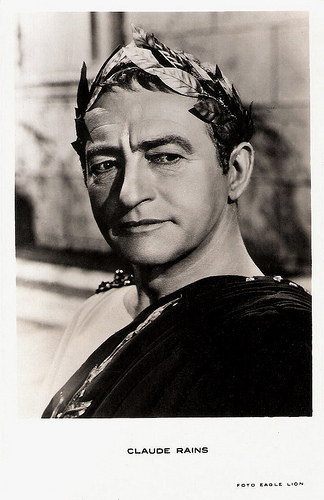
Dutch postcard by HEMO. Photo: Eagle Lion. Publicity still for Caesar and Cleopatra (1945).
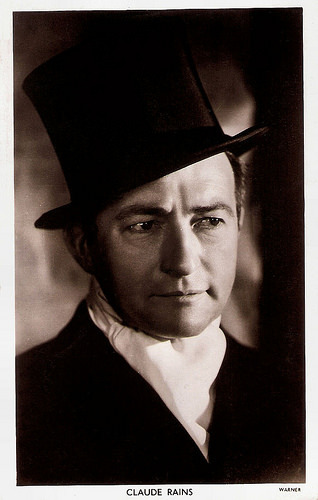
British postcard by the Picturegoer Series, London, no. B.8. Photo: Warner.
A Unique and Solid British Voice
Claude Rains came relatively late to film acting, when he had already reached middle age and established himself as an accomplished stage actor. In 1932, while working for the Theater Guild, Universal Pictures offered him a screen test for a role in A Bill of Divorcement (1933), a part he had already played with considerable conviction on the stage in 1921. Rains had a unique and solid British voice - deep, slightly rasping - but richly dynamic. And as a man of small stature, the combination was immediately intriguing.
Although his screen test was a failure, his distinctive voice won him the title role in the classic fantasy film The Invisible Man (James Whale, 1933) based on the novel by H.G. Wells, when someone accidentally overheard his screen test being played in the next room. In The Invisible Man Rains was kept from view behind gauze bandages and through the magic of special effects. His face appears only briefly, after the character's death renders him visible again, but the strength of his vocal performance alone launched the actor's career in Hollywood.
William McPeak writes at IMDb : “He took the role by the ears, churning up a rasping malice and volume in his voice to achieve a bone chilling persona of the disembodied mad doctor. He could also throw out a high-pitched maniac laugh that would make you leave the lights on before going to bed.“ At AllMovie , Hal Erickson adds: “So forceful was Rains' verbal performance as "The Invisible One" that he became an overnight movie star (after nearly twenty years on stage). Wittily scripted by R.C. Sherriff and an uncredited Philip Wylie, and brilliantly directed by James Whale, The Invisible Man is a near-untoppable combination of horror and humour.”
Following his sensational talking-picture debut, Universal Studios tried to typecast Rains in horror films, but he appeared instead in such interesting films as the Paramount production Crime Without Passion (Ben Hecht, Charles MacArthur, 1934), in which he portrays a man driven to the brink of madness by an unhappy love affair. Rains would play similar characters in subsequent films, as his reserved, ironic manner proved an ideal mask for slowly crumbling sanity.
In Britain, he starred as The Clairvoyant (Maurice Elvey, 1935). By 1936, he was at Warner Bros. with its ambitious laundry list of literary epics in full swing. His malicious, gouty Don Luis in Anthony Adverse (Mervyn LeRoy, Michael Curtiz (uncredited), 1936) was inspired. After a shear lucky opportunity to dispatch his young wife's lover, Louis Hayward, in a duel, he triumphs over her in a scene with derisive, bulging eyes and that high pitched laugh - with appropriate shadow and light backdrop - that is unforgettable.
Another success was his gleefully evil role of Prince John in The Adventures of Robin Hood (Michael Curtiz, William Keighley, 1938). Rains later credited director Michael Curtiz with teaching him the more understated requirements of film acting, or "what not to do in front of a camera".
In 1939, Rains became an American citizen. He was also for the first time nominated for the Academy Award for his performance as the complex, ethics-tortured senator in Mr. Smith Goes to Washington (Frank Capra, 1939). Janet E. Lorenz writes at Film Reference : “His performance in the Capra film exemplifies Rains' ability to portray characters who remain charming — and sometimes sympathetic — in spite of their actions.”
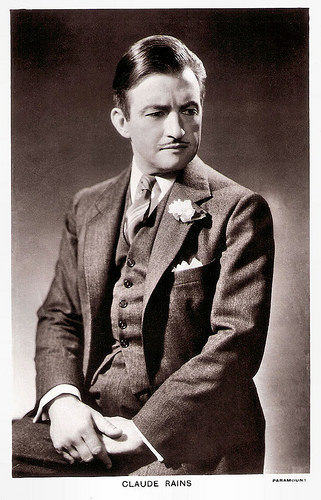
British postcard in the Picturegoer Series, London, no. 917. Photo: Paramount.
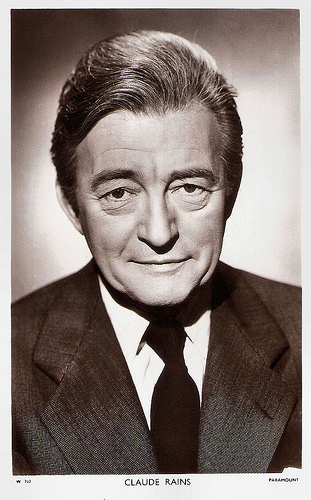
British postcard in the Picturegoer Series, London, no. 712 W. Photo: Paramount.
Bette Davis' Favourite Co-Star
Claude Rains’ most famous role is the flexible French police Captain Renault in Casablanca (Michael Curtiz, 1942). The next year, he played the disfigured music lover who haunts the Paris Opera house in Universal's full-colour remake of Phantom of the Opera (Arthur Lubin, 1943).
Bette Davis named him her favourite co-star, and they made four films together. Janet E. Lorentz: “In Now, Voyager (Irving Rapper, 1942), one of the classic ‘women's films’ of the 1940s, he portrays Davis's wise, understanding psychiatrist, while his performance as her adoring, long-suffering husband in Mr. Skeffington (Vincent Sherman, 1944) brought him another Oscar nomination. The pairing of Davis's electric screen presence with Rains' precise, assured style lends a particular chemistry to their films together.”
Rains became the first actor to receive a million dollar salary, playing Julius Caesar opposite Vivien Leigh in the lavish and unsuccessful version of George Bernard Shaw's Caesar and Cleopatra (Gabriel Pascal, 1945), made in Britain.
In 1946, he played a nervous and malignant refugee Nazi agent in the classic thriller Notorious (Alfred Hitchcock, 1946). Nick Zegarac writes at The Hollywood Art : “a stylish entrée in which, as a suave Nazi supporter living in Mexico City, he attempted to poison his wife ( Ingrid Bergman ) under the watchful eye of an FBI agent (Cary Grant). A formidable success at the box office, the film seemed to place Rains in the envious position to draw star billing once more.”
Four years later, he appeared in The Passionate Friends (David Lean, 1949) with Ann Todd and Trevor Howard .
Claude Rains remained a popular character actor in the 1950s and 1960s, appearing in many films. In 1951, he made a triumphant return to Broadway in Darkness at Noon, for which he won the Tony award. The next year he starred as the title figure in the British film The Man Who Watched Trains Go By (Harold French, 1952). His only singing and dancing role was in a television musical version of The Pied Piper of Hamelin (Bretaigne Windust, 1957), with Van Johnson as the Piper. This NBC colour special, shown as a film rather than a live or videotaped program, was highly successful with the public. Sold into syndication after its first telecast, it was repeated annually by many local TV stations. As a favoured Alfred Hitchcock alumnus, he starred in five Alfred Hitchcock Presents (1956-1962) suspense dramas.
Two of Rains’ well-known later screen roles were as Dryden, a cynical British diplomat in Lawrence of Arabia (David Lean, 1962) featuring Peter O’Toole , and King Herod in The Greatest Story Ever Told (George Stevens, 1965) with Max von Sydow. The latter was his final film role.
Rains made several audio recordings, narrating a few Bible stories for children on Capitol Records, and reciting Richard Strauss' setting for narrator and piano of Tennyson's poem Enoch Arden, with the piano solos played by Glenn Gould. This recording was made by Columbia Masterworks Records.
Claude Rains married six times, the first five of which ended in divorce: actress Isabel Jeans (1913–1915); Marie Hemingway (1920, for less than a year); Beatrix Thomson (1924-1935); Frances Proper (1935–1956); and to classic pianist Agi Jambor (1959–1960). He married Rosemary Clark Schrode in 1960, and stayed with her until her death in 1964. His only child, Jessica Rains, was born to him and Proper in 1938.
Rains died from an abdominal hemorrhage in Laconia, New Hampshire in 1967 at the age of 77. He was nominated four times for the Academy Award for Best Supporting Actor, for Mr. Smith Goes to Washington (1939), Casablanca (1942), Mr. Skeffington (1944), and Notorious (1946). Surprisingly, he never won.
Trailer for The Invisible Man (1933). Source: HorrorfilmKeller (YouTube).
Trailer for The Adventures of Robin Hood (1938). Source: TheTrailerGal (YouTube).
Trailer for The Passionate Friends (1949). Source: K8nairne (YouTube).
Sources: Janet E. Lorenz (Film Reference), Hal Erickson (AllMovie), Nick Zegarac (The Hollywood Art), (IMDb), Brian McFarlane (Encyclopedia of British Film), Donald Greyfield (Find a Grave), Wikipedia, and .

Italian postcard in the Artisti del Cinema Series, no. 100, by Edizione ELAH, La vasa delle Caramelle. Photo: Warner Bros. Publicity still for They Won't Forget (Mervyn LeRoy, 1937).
Gas Attack
William Claude Rains was born in Camberwell, London in 1889. In 2008, his daughter Jessica Rains and David J. Skal would publish the biography Claude Rains: An Actor's Voice. According to Jessica, he grew up, with "a very serious cockney accent and a speech impediment". His father was English stage actor and later film director Frederick Rains.
In 1900, the 11 year-old Rains made his stage debut as a boy singer in Sweet Nell of Old Drury. He learned the technical end of the business by working his way up from being a two-dollars-a-week page boy to assistant stage manager at His Majesty's Theatre in London. In 1911, he made his adult stage debut in Gods of the Mountains.
His acting talents were recognised by Sir Herbert Beerbohm Tree, founder of The Royal Academy of Dramatic Art. Tree paid for the elocution lessons Rains needed in order to succeed as an actor. After making his American stage debut in tour with Granville Barker's troupe in Androcles and the Lion, Rains returned to England.
He served in the First World War in the London Scottish Regiment, with fellow actors Basil Rathbone, Ronald Colman and Herbert Marshall . Rains was involved in a gas attack that left him nearly blind in one eye for the rest of his life. However, the war did aid his social advancement and, by its end, he had risen from the rank of Private to Captain.
Rains began his career in the London theatre, having a success in the title role of John Drinkwater's play Ulysses S. Grant, the follow-up to the playwright's major hit Abraham Lincoln. His one and only silent film venture was a small part in the British production Build Thy House (Fred Goodwins, 1920) starring Henry Ainley and Warwick Ward . This film is now considered as lost.
In the 1920s, Rains taught at The Royal Academy of Dramatic Art. Among his pupils were John Gielgud , Laurence Olivier , and the lovely Isabel Jeans, who became the first of his six wives.
In 1926, he travelled again to the USA on tour with the play The Constant Nymph and he decided to stay. In the following years he played leading roles with the Theater Guild on Broadway in such plays as George Bernard Shaw's The Apple Cart and in the dramatisation of Pearl S. Buck's novel The Good Earth.

Dutch postcard by HEMO. Photo: Eagle Lion. Publicity still for Caesar and Cleopatra (1945).

British postcard by the Picturegoer Series, London, no. B.8. Photo: Warner.
A Unique and Solid British Voice
Claude Rains came relatively late to film acting, when he had already reached middle age and established himself as an accomplished stage actor. In 1932, while working for the Theater Guild, Universal Pictures offered him a screen test for a role in A Bill of Divorcement (1933), a part he had already played with considerable conviction on the stage in 1921. Rains had a unique and solid British voice - deep, slightly rasping - but richly dynamic. And as a man of small stature, the combination was immediately intriguing.
Although his screen test was a failure, his distinctive voice won him the title role in the classic fantasy film The Invisible Man (James Whale, 1933) based on the novel by H.G. Wells, when someone accidentally overheard his screen test being played in the next room. In The Invisible Man Rains was kept from view behind gauze bandages and through the magic of special effects. His face appears only briefly, after the character's death renders him visible again, but the strength of his vocal performance alone launched the actor's career in Hollywood.
William McPeak writes at IMDb : “He took the role by the ears, churning up a rasping malice and volume in his voice to achieve a bone chilling persona of the disembodied mad doctor. He could also throw out a high-pitched maniac laugh that would make you leave the lights on before going to bed.“ At AllMovie , Hal Erickson adds: “So forceful was Rains' verbal performance as "The Invisible One" that he became an overnight movie star (after nearly twenty years on stage). Wittily scripted by R.C. Sherriff and an uncredited Philip Wylie, and brilliantly directed by James Whale, The Invisible Man is a near-untoppable combination of horror and humour.”
Following his sensational talking-picture debut, Universal Studios tried to typecast Rains in horror films, but he appeared instead in such interesting films as the Paramount production Crime Without Passion (Ben Hecht, Charles MacArthur, 1934), in which he portrays a man driven to the brink of madness by an unhappy love affair. Rains would play similar characters in subsequent films, as his reserved, ironic manner proved an ideal mask for slowly crumbling sanity.
In Britain, he starred as The Clairvoyant (Maurice Elvey, 1935). By 1936, he was at Warner Bros. with its ambitious laundry list of literary epics in full swing. His malicious, gouty Don Luis in Anthony Adverse (Mervyn LeRoy, Michael Curtiz (uncredited), 1936) was inspired. After a shear lucky opportunity to dispatch his young wife's lover, Louis Hayward, in a duel, he triumphs over her in a scene with derisive, bulging eyes and that high pitched laugh - with appropriate shadow and light backdrop - that is unforgettable.
Another success was his gleefully evil role of Prince John in The Adventures of Robin Hood (Michael Curtiz, William Keighley, 1938). Rains later credited director Michael Curtiz with teaching him the more understated requirements of film acting, or "what not to do in front of a camera".
In 1939, Rains became an American citizen. He was also for the first time nominated for the Academy Award for his performance as the complex, ethics-tortured senator in Mr. Smith Goes to Washington (Frank Capra, 1939). Janet E. Lorenz writes at Film Reference : “His performance in the Capra film exemplifies Rains' ability to portray characters who remain charming — and sometimes sympathetic — in spite of their actions.”

British postcard in the Picturegoer Series, London, no. 917. Photo: Paramount.

British postcard in the Picturegoer Series, London, no. 712 W. Photo: Paramount.
Bette Davis' Favourite Co-Star
Claude Rains’ most famous role is the flexible French police Captain Renault in Casablanca (Michael Curtiz, 1942). The next year, he played the disfigured music lover who haunts the Paris Opera house in Universal's full-colour remake of Phantom of the Opera (Arthur Lubin, 1943).
Bette Davis named him her favourite co-star, and they made four films together. Janet E. Lorentz: “In Now, Voyager (Irving Rapper, 1942), one of the classic ‘women's films’ of the 1940s, he portrays Davis's wise, understanding psychiatrist, while his performance as her adoring, long-suffering husband in Mr. Skeffington (Vincent Sherman, 1944) brought him another Oscar nomination. The pairing of Davis's electric screen presence with Rains' precise, assured style lends a particular chemistry to their films together.”
Rains became the first actor to receive a million dollar salary, playing Julius Caesar opposite Vivien Leigh in the lavish and unsuccessful version of George Bernard Shaw's Caesar and Cleopatra (Gabriel Pascal, 1945), made in Britain.
In 1946, he played a nervous and malignant refugee Nazi agent in the classic thriller Notorious (Alfred Hitchcock, 1946). Nick Zegarac writes at The Hollywood Art : “a stylish entrée in which, as a suave Nazi supporter living in Mexico City, he attempted to poison his wife ( Ingrid Bergman ) under the watchful eye of an FBI agent (Cary Grant). A formidable success at the box office, the film seemed to place Rains in the envious position to draw star billing once more.”
Four years later, he appeared in The Passionate Friends (David Lean, 1949) with Ann Todd and Trevor Howard .
Claude Rains remained a popular character actor in the 1950s and 1960s, appearing in many films. In 1951, he made a triumphant return to Broadway in Darkness at Noon, for which he won the Tony award. The next year he starred as the title figure in the British film The Man Who Watched Trains Go By (Harold French, 1952). His only singing and dancing role was in a television musical version of The Pied Piper of Hamelin (Bretaigne Windust, 1957), with Van Johnson as the Piper. This NBC colour special, shown as a film rather than a live or videotaped program, was highly successful with the public. Sold into syndication after its first telecast, it was repeated annually by many local TV stations. As a favoured Alfred Hitchcock alumnus, he starred in five Alfred Hitchcock Presents (1956-1962) suspense dramas.
Two of Rains’ well-known later screen roles were as Dryden, a cynical British diplomat in Lawrence of Arabia (David Lean, 1962) featuring Peter O’Toole , and King Herod in The Greatest Story Ever Told (George Stevens, 1965) with Max von Sydow. The latter was his final film role.
Rains made several audio recordings, narrating a few Bible stories for children on Capitol Records, and reciting Richard Strauss' setting for narrator and piano of Tennyson's poem Enoch Arden, with the piano solos played by Glenn Gould. This recording was made by Columbia Masterworks Records.
Claude Rains married six times, the first five of which ended in divorce: actress Isabel Jeans (1913–1915); Marie Hemingway (1920, for less than a year); Beatrix Thomson (1924-1935); Frances Proper (1935–1956); and to classic pianist Agi Jambor (1959–1960). He married Rosemary Clark Schrode in 1960, and stayed with her until her death in 1964. His only child, Jessica Rains, was born to him and Proper in 1938.
Rains died from an abdominal hemorrhage in Laconia, New Hampshire in 1967 at the age of 77. He was nominated four times for the Academy Award for Best Supporting Actor, for Mr. Smith Goes to Washington (1939), Casablanca (1942), Mr. Skeffington (1944), and Notorious (1946). Surprisingly, he never won.
Trailer for The Invisible Man (1933). Source: HorrorfilmKeller (YouTube).
Trailer for The Adventures of Robin Hood (1938). Source: TheTrailerGal (YouTube).
Trailer for The Passionate Friends (1949). Source: K8nairne (YouTube).
Sources: Janet E. Lorenz (Film Reference), Hal Erickson (AllMovie), Nick Zegarac (The Hollywood Art), (IMDb), Brian McFarlane (Encyclopedia of British Film), Donald Greyfield (Find a Grave), Wikipedia, and .
Published on January 27, 2016 22:00
January 26, 2016
Der Kaufmann von Venedig (1923)
Henny Porten and Harry Liedtke are two of the three stars of the German silent film Der Kaufmann von Venedig (Peter Paul Felner, 1923). It was based on the classic stage play The Merchant of Venice by William Shakespeare. But where is Shylock?
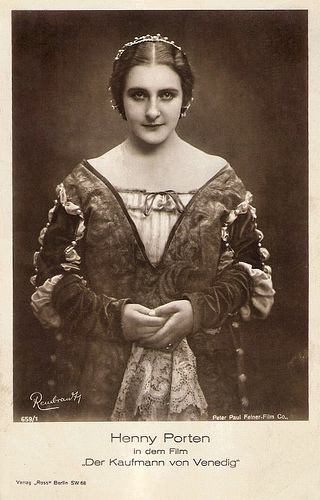
German postcard by Ross Verlag, no. 659/1, 1923-1924. Photo: Rembrandt / Peter Paul Felner-Film Co. Publicity still for Der Kaufmann von Venedig/The Merchant Of Venice (Peter Paul Felner, 1923).
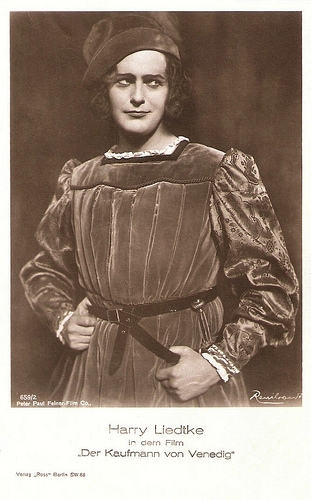
German postcard by Ross Verlag, no. 659/2. Photo: Rembrandt / Peter Paul Felner Film Co. Publicity still for Der Kaufmann von Venedig/The Merchant Of Venice (Peter Paul Felner, 1923).
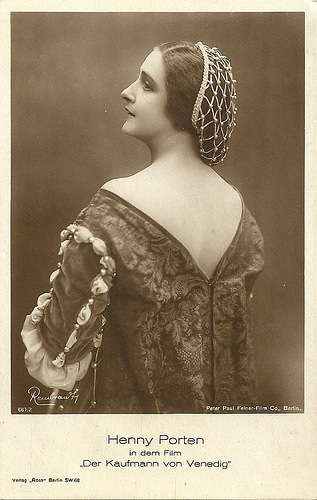
German postcard by Ross Verlag, no. 661/2. Photo: Rembrandt / Peter Paul Felner-Film Co. Publicity still for Der Kaufmann von Venedig/The Merchant of Venice (Peter Paul Felner, 1923).
Where is Shylock?
Sturdy and blond Henny Porten (1890-1960) was one of Germany's most important and popular film actresses of the silent cinema. Harry Liedtke (1882-1945) was the charming ladykiller of many early silent classics. Detective serials like Joe Deebs made him one of the first male stars of the German cinema.
The two met in Der Kaufmann von Venedig (Peter Paul Felner, 1923), a free silent film adaptation of Shakespeare's The Merchant of Venice. It was released in the United States in 1926 as The Jew of Mestri. The film was made on location in Venice, with scenes and characters added which were not in the original play. Directors of photography were Axel Graatkjær and the future Hollywood director Rudolph Maté. The only surviving copy of the film is an English one which is two reels shorter than the German version.
Porten plays the beautiful and wealthy heiress Portia of Belmont and Liedtke her noble but poor admirer Bassanio. Carl Ebert plays Basasanio's friend Antonio, the merchant of Venice, who wants to help his friend. Other roles were for Max Schreck (Nosferatu!) as The Doge of Venice, Ferdinand von Alten as the Prince of Arragonand, Lia Eibenschütz as Portia's friend Jessica.
But where is Shylock? Where is the Jewish moneylender who offers Antonio the money for his friend, but wants a pound of his flesh if he can't repay the loan? Shylock is played by Werner Krauss , but we could not find any postcards of him (yet).
Der Kaufmann von Venedig was written, produced and directed by Peter Paul Felner. Did he good job? At IMDb , Ferdinand Von Galitzien writes: "It is an elegant and expensive German film production that was shot on location in beautiful and decadent Venice". However, he adds: "In spite of such important literary material (...) and reputable actors, Felner's direction is ordinary and even boring. He does little more than illustrate some passages of the manuscript and then counts on the beauty of Venice to do the rest. Alas, it's not enough."
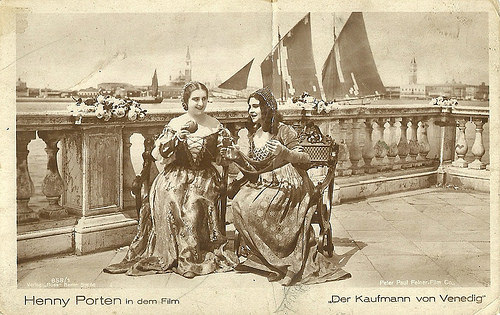
German postcard by Ross Verlag, no. 658/1. Photo: Peter Paul Felner-Film Co. Publicity still for Der Kaufmann von Venedig/The Merchant of Venice (Peter Paul Felner, 1923) with Henny Porten and Lia Eibenschütz.
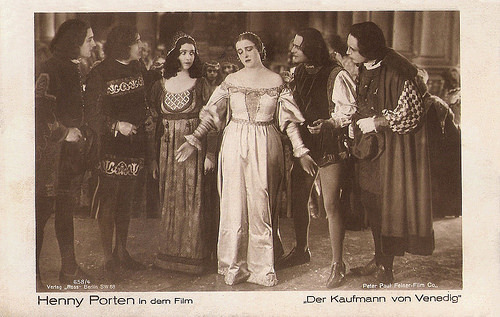
German postcard by Ross Verlag, no. 658/4. Photo: Peter Paul Felner-Film Co. Publicity still for Der Kaufmann von Venedig/The Merchant of Venice (Peter Paul Felner, 1923).
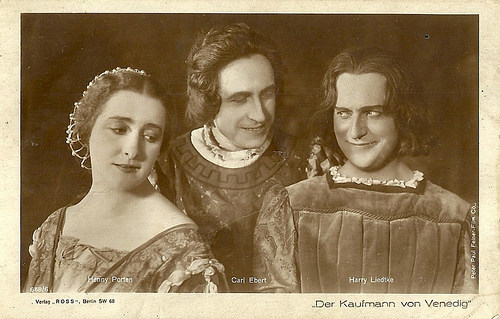
German postcard by Ross Verlag, no. 658/6. Photo: Peter Paul Felner-Film Co. Publicity still for Der Kaufmann von Venedig/The Merchant of Venice (Peter Paul Felner, 1923) with Henny Porten , Carl Ebert and Harry Liedtke .
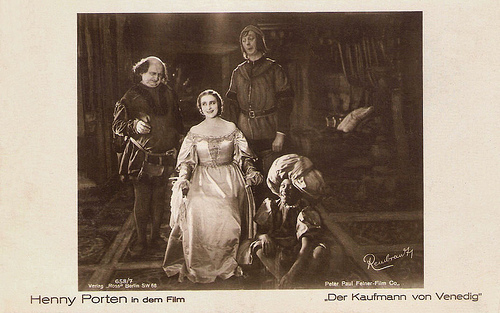
German postcard by Ross Verlag, no. 658/7. Photo: Rembrandt / Peter Paul Felner-Film Co. Publicity still for Der Kaufmann von Venedig/The Merchant of Venice (Peter Paul Felner, 1923).
Sources: Ferdinand Von Galitzien (IMDb), Wikipedia (German and English) and IMDb.

German postcard by Ross Verlag, no. 659/1, 1923-1924. Photo: Rembrandt / Peter Paul Felner-Film Co. Publicity still for Der Kaufmann von Venedig/The Merchant Of Venice (Peter Paul Felner, 1923).

German postcard by Ross Verlag, no. 659/2. Photo: Rembrandt / Peter Paul Felner Film Co. Publicity still for Der Kaufmann von Venedig/The Merchant Of Venice (Peter Paul Felner, 1923).

German postcard by Ross Verlag, no. 661/2. Photo: Rembrandt / Peter Paul Felner-Film Co. Publicity still for Der Kaufmann von Venedig/The Merchant of Venice (Peter Paul Felner, 1923).
Where is Shylock?
Sturdy and blond Henny Porten (1890-1960) was one of Germany's most important and popular film actresses of the silent cinema. Harry Liedtke (1882-1945) was the charming ladykiller of many early silent classics. Detective serials like Joe Deebs made him one of the first male stars of the German cinema.
The two met in Der Kaufmann von Venedig (Peter Paul Felner, 1923), a free silent film adaptation of Shakespeare's The Merchant of Venice. It was released in the United States in 1926 as The Jew of Mestri. The film was made on location in Venice, with scenes and characters added which were not in the original play. Directors of photography were Axel Graatkjær and the future Hollywood director Rudolph Maté. The only surviving copy of the film is an English one which is two reels shorter than the German version.
Porten plays the beautiful and wealthy heiress Portia of Belmont and Liedtke her noble but poor admirer Bassanio. Carl Ebert plays Basasanio's friend Antonio, the merchant of Venice, who wants to help his friend. Other roles were for Max Schreck (Nosferatu!) as The Doge of Venice, Ferdinand von Alten as the Prince of Arragonand, Lia Eibenschütz as Portia's friend Jessica.
But where is Shylock? Where is the Jewish moneylender who offers Antonio the money for his friend, but wants a pound of his flesh if he can't repay the loan? Shylock is played by Werner Krauss , but we could not find any postcards of him (yet).
Der Kaufmann von Venedig was written, produced and directed by Peter Paul Felner. Did he good job? At IMDb , Ferdinand Von Galitzien writes: "It is an elegant and expensive German film production that was shot on location in beautiful and decadent Venice". However, he adds: "In spite of such important literary material (...) and reputable actors, Felner's direction is ordinary and even boring. He does little more than illustrate some passages of the manuscript and then counts on the beauty of Venice to do the rest. Alas, it's not enough."

German postcard by Ross Verlag, no. 658/1. Photo: Peter Paul Felner-Film Co. Publicity still for Der Kaufmann von Venedig/The Merchant of Venice (Peter Paul Felner, 1923) with Henny Porten and Lia Eibenschütz.

German postcard by Ross Verlag, no. 658/4. Photo: Peter Paul Felner-Film Co. Publicity still for Der Kaufmann von Venedig/The Merchant of Venice (Peter Paul Felner, 1923).

German postcard by Ross Verlag, no. 658/6. Photo: Peter Paul Felner-Film Co. Publicity still for Der Kaufmann von Venedig/The Merchant of Venice (Peter Paul Felner, 1923) with Henny Porten , Carl Ebert and Harry Liedtke .

German postcard by Ross Verlag, no. 658/7. Photo: Rembrandt / Peter Paul Felner-Film Co. Publicity still for Der Kaufmann von Venedig/The Merchant of Venice (Peter Paul Felner, 1923).
Sources: Ferdinand Von Galitzien (IMDb), Wikipedia (German and English) and IMDb.
Published on January 26, 2016 22:00
January 25, 2016
Auf Probe gestellt (1918)
Another popular film with sturdy and blonde German diva Henny Porten (1890-1960) was the silent comedy Auf Probe gestellt/Put to the test (Rudolf Biebrach, 1918). Behind the camera were several talented artists working who would become very important for the Weimar cinema.
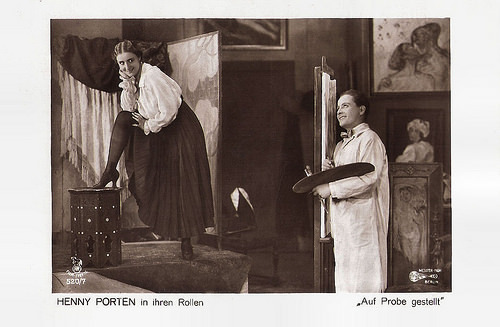
German postcard in the Film Sterne series by Rotophot, no. 520/7. Photo: Messter Film, Berlin. Publicity still for Auf Probe gestellt/Put to the test (Rudolf Biebrach, 1918) with Henny Porten and Hermann Thimig .
Put to the marriage test
In Auf Probe gestellt/Put to the test (Rudolf Biebrach, 1918), Henny Porten portrays the the young and impoverished widower Countess Marlene von Steinitz.
At the instance of her brother-in-law, Count Steinitz (Heinrich Schroth), she plans to marry the stupid but extremely rich Count Adolar von Warowingen ( Reinhold Schünzel ), which would liberate her from all her problems at once.
She asks Count Steinitz a delay of eight days and travels to the city to find a solution and enjoy her free life one last time. At an artists party she meets painter Frank Merwin ( Hermann Thimig ), seduces him and manages to invite the handsome young man to her castle.
When he awakes from his dream, he is treated like a famous personality by all bystanders. Marlene pretends to be his bride, putting him to the test to see if he is any good as husband.
Though Merwin stands the test poorly, and he is sent back to his shabby room, the Countess decides to have him, leaving Count Adolar with a basket as gift, and betrothing Frank in the city.
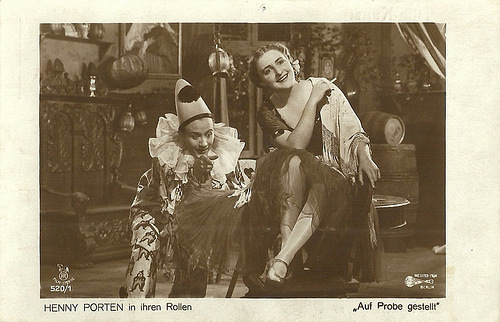
German postcard in the Film Sterne series by Rotophot, no. 520/1. Photo: Messter Film, Berlin. Publicity still for Auf Probe gestellt/Put to the test (Rudolf Biebrach, 1918) with Henny Porten .
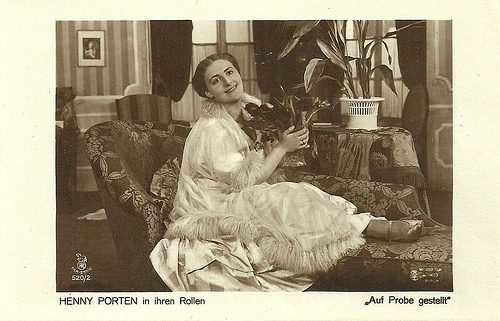
German postcard in the Film Sterne series by Rotophot, no. 520/2. Photo: Messter Film, Berlin. Publicity still for Auf Probe gestellt/Put to the test (Rudolf Biebrach, 1918) with Henny Porten .
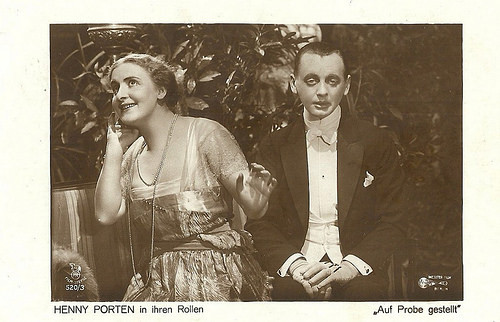
German postcard in the Film Sterne series by Rotophot, no. 520/3. Photo: Messter Film, Berlin. Publicity still for Auf Probe gestellt/Put to the test (Rudolf Biebrach, 1918) with Henny Porten and Reinhold Schünzel .
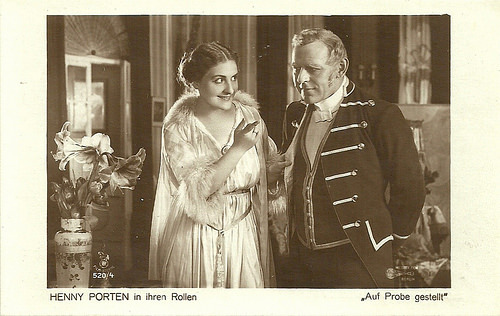
German postcard in the Film Sterne series by Rotophot, no. 520/4. Photo: Messter Film, Berlin. Publicity still for Auf Probe gestellt/Put to the test (Rudolf Biebrach, 1918) with Henny Porten .
The talent behind Auf Probe gestellt
The script of Auf Probe gestellt/Put to the test was written by Robert Wiene, the future director of the classic silent horror film Das Cabinet des Dr. Caligari/The Cabinet of Dr. Caligari (1920)
Ludwig Kainer had designed the sets for the film. Kainer designed the sets of all the late 1910s films with Porten and director Rudolf Biebrach.
The camera work was done by famous cinematographer and future director Karl Freund. He had shot many of the late 1910s films with Porten and directed by Biebrach. The following year, in 1919, Freund would become the close collaborator of director Friedrich Wilhelm Murnau.
Auf Probe gestellt premiered on 15 March 1918 at the Mozartsaal cinema in the heart of Berlin.
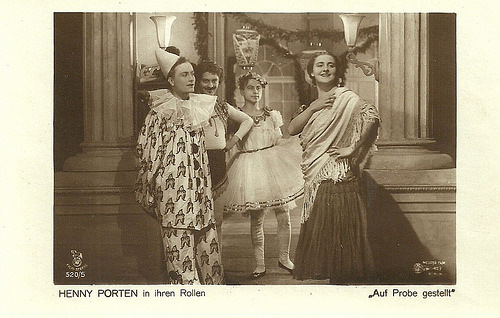
German postcard in the Film Sterne series by Rotophot, no. 520/5. Photo: Messter Film, Berlin. Publicity still for Auf Probe gestellt/Put to the test (Rudolf Biebrach, 1918) with Henny Porten .
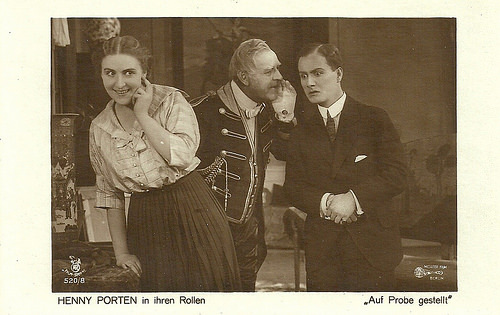
German postcard in the Film Sterne series by Rotophot, no. 520/8. Photo: Messter Film, Berlin. Publicity still for Auf Probe gestellt/Put to the test (Rudolf Biebrach, 1918) with Henny Porten and Hermann Thimig .
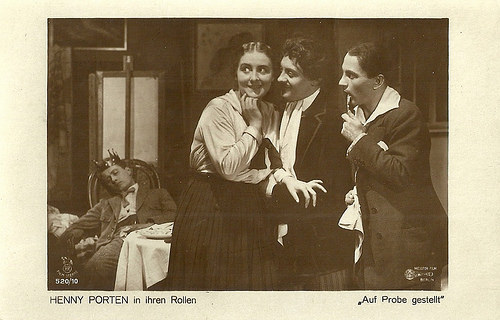
German postcard in the Film Sterne series by Rotophot, no. 520/10. Photo: Messter Film, Berlin. Publicity still for Auf Probe gestellt/Put to the test (Rudolf Biebrach, 1918).
Sources: Wikipedia (German) and IMDb.

German postcard in the Film Sterne series by Rotophot, no. 520/7. Photo: Messter Film, Berlin. Publicity still for Auf Probe gestellt/Put to the test (Rudolf Biebrach, 1918) with Henny Porten and Hermann Thimig .
Put to the marriage test
In Auf Probe gestellt/Put to the test (Rudolf Biebrach, 1918), Henny Porten portrays the the young and impoverished widower Countess Marlene von Steinitz.
At the instance of her brother-in-law, Count Steinitz (Heinrich Schroth), she plans to marry the stupid but extremely rich Count Adolar von Warowingen ( Reinhold Schünzel ), which would liberate her from all her problems at once.
She asks Count Steinitz a delay of eight days and travels to the city to find a solution and enjoy her free life one last time. At an artists party she meets painter Frank Merwin ( Hermann Thimig ), seduces him and manages to invite the handsome young man to her castle.
When he awakes from his dream, he is treated like a famous personality by all bystanders. Marlene pretends to be his bride, putting him to the test to see if he is any good as husband.
Though Merwin stands the test poorly, and he is sent back to his shabby room, the Countess decides to have him, leaving Count Adolar with a basket as gift, and betrothing Frank in the city.

German postcard in the Film Sterne series by Rotophot, no. 520/1. Photo: Messter Film, Berlin. Publicity still for Auf Probe gestellt/Put to the test (Rudolf Biebrach, 1918) with Henny Porten .

German postcard in the Film Sterne series by Rotophot, no. 520/2. Photo: Messter Film, Berlin. Publicity still for Auf Probe gestellt/Put to the test (Rudolf Biebrach, 1918) with Henny Porten .

German postcard in the Film Sterne series by Rotophot, no. 520/3. Photo: Messter Film, Berlin. Publicity still for Auf Probe gestellt/Put to the test (Rudolf Biebrach, 1918) with Henny Porten and Reinhold Schünzel .

German postcard in the Film Sterne series by Rotophot, no. 520/4. Photo: Messter Film, Berlin. Publicity still for Auf Probe gestellt/Put to the test (Rudolf Biebrach, 1918) with Henny Porten .
The talent behind Auf Probe gestellt
The script of Auf Probe gestellt/Put to the test was written by Robert Wiene, the future director of the classic silent horror film Das Cabinet des Dr. Caligari/The Cabinet of Dr. Caligari (1920)
Ludwig Kainer had designed the sets for the film. Kainer designed the sets of all the late 1910s films with Porten and director Rudolf Biebrach.
The camera work was done by famous cinematographer and future director Karl Freund. He had shot many of the late 1910s films with Porten and directed by Biebrach. The following year, in 1919, Freund would become the close collaborator of director Friedrich Wilhelm Murnau.
Auf Probe gestellt premiered on 15 March 1918 at the Mozartsaal cinema in the heart of Berlin.

German postcard in the Film Sterne series by Rotophot, no. 520/5. Photo: Messter Film, Berlin. Publicity still for Auf Probe gestellt/Put to the test (Rudolf Biebrach, 1918) with Henny Porten .

German postcard in the Film Sterne series by Rotophot, no. 520/8. Photo: Messter Film, Berlin. Publicity still for Auf Probe gestellt/Put to the test (Rudolf Biebrach, 1918) with Henny Porten and Hermann Thimig .

German postcard in the Film Sterne series by Rotophot, no. 520/10. Photo: Messter Film, Berlin. Publicity still for Auf Probe gestellt/Put to the test (Rudolf Biebrach, 1918).
Sources: Wikipedia (German) and IMDb.
Published on January 25, 2016 22:00
January 24, 2016
Henny Porten, Part 2
Sturdy and blond Henny Porten (1890-1960) was one of Germany's most important and popular film actresses of the silent cinema. She was also the producer of many of her own films. But what happened with her after the arrival of sound film?
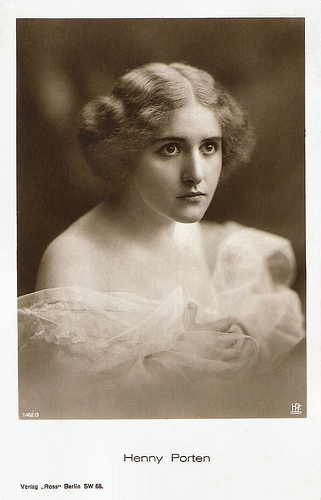
German postcard by Ross Verlag, Berlin, no. 1462/3, 1927-1928. Photo: HPF.
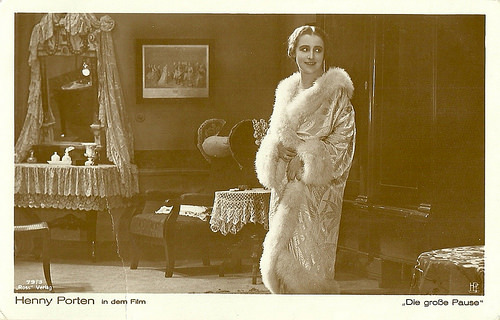
German postcard by Ross Verlag, no. 79/3. Photo: Henny Porten-Film. Henny Porten in the German silent film Die grosse Pause (Carl Froehlich, 1927).
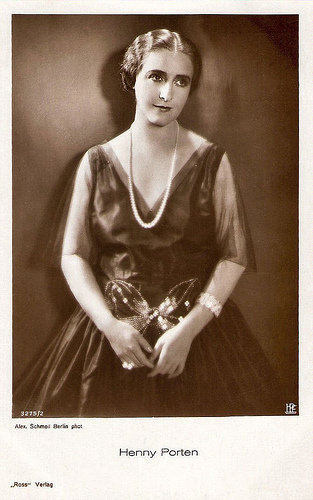
German Postcard by Ross Verlag, no. 3275/2, 1928-1929. Photo: Alex. Schmoll, Berlin.
Trouble with Goebbels
Henny Porten seemed to pass from silent to sound cinema without any obstacles. She starred in such films as Mutterliebe/Mother Love (Georg Jacoby, 1929) with Gustav Diessl , Die Herrin und ihr Knecht/The Boss and Her Servant (Richard Oswald, 1929) with Mary Kid , and a remake of Kohlhiesels Töchter/Kohlhiesel's Daughters (Hans Behrendt, 1930) opposite Fritz Kampers.
The following year she achieved her long planned for project, the film Luise, Königin von Preußen/Luise, Queen of Prussia (Carl Froelich, 1931) with Gustaf Gründgens, which ultimately bankrupted her company in the summer of 1932. After this project, Porten was considered to be a risk within the film industry. With no film engagements coming, she sought refuge on stage.
She achieved renewed film success in the autumn of 1933, with the sound film remake of Mutter und Kind/Mother and Child (Hans Steinhoff, 1933). She had become the quintessence of German womanhood, ladylike yet kindhearted and a not a little petit bourgeois.
There were years Henny Porten had done twelve films a year, but the Nazi takeover of Germany in 1933 brought her career to an almost standstill. Her refusal to divorce her Jewish husband Wilhelm von Kaufmann got her in trouble with propaganda minister Josef Goebbels.
When she resolved on emigration to join Ernst Lubitsch in Hollywood, he denied her an exit visa to prevent a negative impression. Goebbels tried to ban her from the film industry, but she made a few films after Allied bombardment started, and her placid and reassuring persona helped calm audiences.
In 1937 she was taken on by the Tobis company on a work for money basis, but was never offered any work. Porten was permitted to work in such Austrian-made films as the comedy Der Optimist/The Optimist (E.W. Emo, 1938) with Viktor de Kowa and Theo Lingen , and the crime drama War es der im Dritten Stock/Was It Him on the Third Floor? (Carl Boese, 1938).
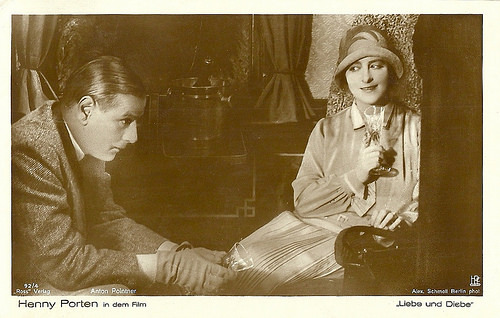
German postcard by Ross Verlag, no. 92/4. Photo: Henny Porten-Film / Photo Atelier Alex. Schmoll, Berlin. Henny Porten and Anton Pointner in the German silent romantic comedy Liebe und Diebe/Love and Thieves (Carl Froehlich, 1928).
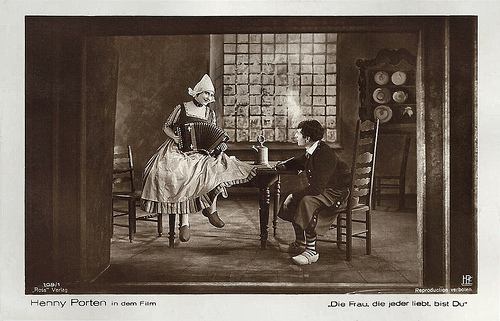
German Postcard by Ross Verlag, no. 109/1. Photo: Henny Porten Film. Publicity still for Die Frau, die jeder liebst, bist Du (Carl Froehlich, 1928-1929).
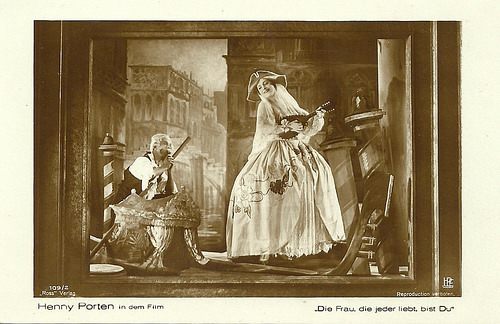
German Postcard by Ross Verlag, no. 109/2. Photo: Henny Porten Film. Publicity still for Die Frau, die jeder liebst, bist Du (Carl Froehlich, 1928-1929).
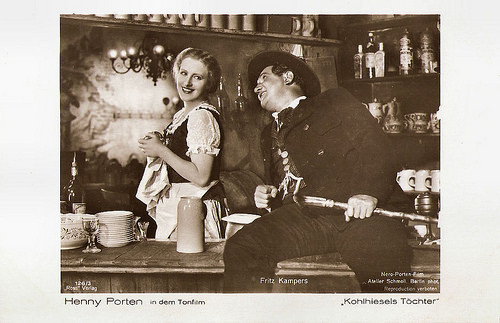
German postcard by Ross Verlag, no. 126/3. Photo: Atelier Schmoll, Berlin / Nero-Porten-Film. Publicity still for Kohlhiesels Töchter/Kohlhiesel's Daughters (Hans Behrendt, 1930) with Fritz Kampers.
Deserting to the DDR
Henny Porten was hired by old friend G.W. Pabst to play the duchess in Komödianten/The Comedians (Georg Wilhelm Pabst, 1941) with Käthe Dorsch and Hilde Krahl , and she was reunited with Carl Froelich for the homey comedy Familie Buchholz/The Buchholz Family (Carl Froelich, 1944).
In 1944, after an aerial mine destroyed their home, Porten and her husband were out on the streets, as it was forbidden to shelter a full Jew.
After the war, offers remained poor. Henny Porten lived in Ratzeburg and performed in Lübeck and the Hamburg Theater in 1947. She was given a small role in the comedy Absender unbekannt/Sender unknown (Ákos Ráthonyi, 1950).
So in 1953 she followed an invitation made by the DEFA studio to go east to the new DDR. There she played leading roles in Carola Lamberti - Eine vom Zirkus/Carola Lamberti - One From the Circus (Hans Müller, 1954) and the crime drama Das Fräulein von Scuderi/The Miss from Scuderi (Eugen York, 1955), which would prove to be her last film.
In the Western press her step was branded as that of a 'deserter'. When Porten and her husband returned to Ratzeburg in 1955, they were evicted by their landlord. Von Kaufmann lost his practice. Through the press, Porten unsuccessfully asked for work in film.
They moved to Berlin in 1957, where Von Kaufmann died in 1959. In 1960, Henny Porten finally was awarded the Bundesverdienstkreuz, but she died after suffering a severe illness a few months later.
Between 1906 and 1955 Henny Porten had appeared in over 170 films.
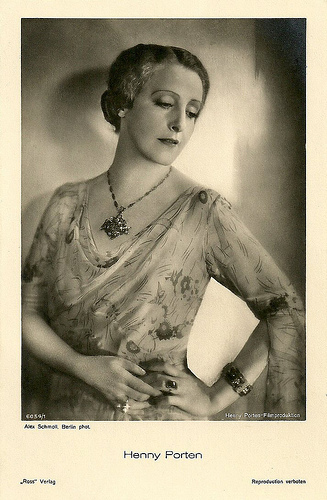
German postcard by Ross Verlag, no. 6059/4, 1931-1932. Photo Alex Schmidt, Berlin / Henny-Porten-Filmproduktion.
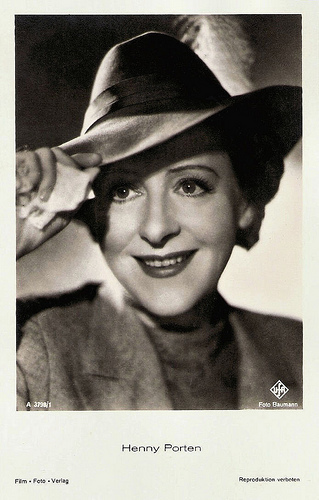
German postcard by Film-Foto-Verlag, no. A 3787/1, 1941-1944. Photo: Baumann / Ufa.
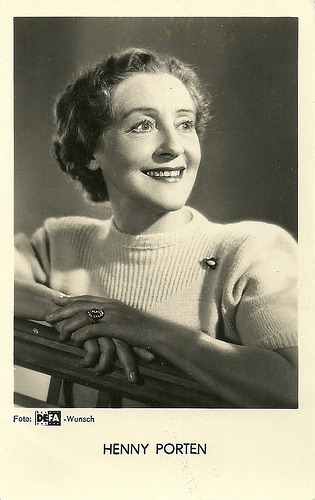
German postcard. Photo: DEFA / Wunsch.
Sources: Thomas Staedeli (Cyranos), Hans J. Wollstein (AllMovie), (IMDb), Filmportal.de , Wikipedia and .

German postcard by Ross Verlag, Berlin, no. 1462/3, 1927-1928. Photo: HPF.

German postcard by Ross Verlag, no. 79/3. Photo: Henny Porten-Film. Henny Porten in the German silent film Die grosse Pause (Carl Froehlich, 1927).

German Postcard by Ross Verlag, no. 3275/2, 1928-1929. Photo: Alex. Schmoll, Berlin.
Trouble with Goebbels
Henny Porten seemed to pass from silent to sound cinema without any obstacles. She starred in such films as Mutterliebe/Mother Love (Georg Jacoby, 1929) with Gustav Diessl , Die Herrin und ihr Knecht/The Boss and Her Servant (Richard Oswald, 1929) with Mary Kid , and a remake of Kohlhiesels Töchter/Kohlhiesel's Daughters (Hans Behrendt, 1930) opposite Fritz Kampers.
The following year she achieved her long planned for project, the film Luise, Königin von Preußen/Luise, Queen of Prussia (Carl Froelich, 1931) with Gustaf Gründgens, which ultimately bankrupted her company in the summer of 1932. After this project, Porten was considered to be a risk within the film industry. With no film engagements coming, she sought refuge on stage.
She achieved renewed film success in the autumn of 1933, with the sound film remake of Mutter und Kind/Mother and Child (Hans Steinhoff, 1933). She had become the quintessence of German womanhood, ladylike yet kindhearted and a not a little petit bourgeois.
There were years Henny Porten had done twelve films a year, but the Nazi takeover of Germany in 1933 brought her career to an almost standstill. Her refusal to divorce her Jewish husband Wilhelm von Kaufmann got her in trouble with propaganda minister Josef Goebbels.
When she resolved on emigration to join Ernst Lubitsch in Hollywood, he denied her an exit visa to prevent a negative impression. Goebbels tried to ban her from the film industry, but she made a few films after Allied bombardment started, and her placid and reassuring persona helped calm audiences.
In 1937 she was taken on by the Tobis company on a work for money basis, but was never offered any work. Porten was permitted to work in such Austrian-made films as the comedy Der Optimist/The Optimist (E.W. Emo, 1938) with Viktor de Kowa and Theo Lingen , and the crime drama War es der im Dritten Stock/Was It Him on the Third Floor? (Carl Boese, 1938).

German postcard by Ross Verlag, no. 92/4. Photo: Henny Porten-Film / Photo Atelier Alex. Schmoll, Berlin. Henny Porten and Anton Pointner in the German silent romantic comedy Liebe und Diebe/Love and Thieves (Carl Froehlich, 1928).

German Postcard by Ross Verlag, no. 109/1. Photo: Henny Porten Film. Publicity still for Die Frau, die jeder liebst, bist Du (Carl Froehlich, 1928-1929).

German Postcard by Ross Verlag, no. 109/2. Photo: Henny Porten Film. Publicity still for Die Frau, die jeder liebst, bist Du (Carl Froehlich, 1928-1929).

German postcard by Ross Verlag, no. 126/3. Photo: Atelier Schmoll, Berlin / Nero-Porten-Film. Publicity still for Kohlhiesels Töchter/Kohlhiesel's Daughters (Hans Behrendt, 1930) with Fritz Kampers.
Deserting to the DDR
Henny Porten was hired by old friend G.W. Pabst to play the duchess in Komödianten/The Comedians (Georg Wilhelm Pabst, 1941) with Käthe Dorsch and Hilde Krahl , and she was reunited with Carl Froelich for the homey comedy Familie Buchholz/The Buchholz Family (Carl Froelich, 1944).
In 1944, after an aerial mine destroyed their home, Porten and her husband were out on the streets, as it was forbidden to shelter a full Jew.
After the war, offers remained poor. Henny Porten lived in Ratzeburg and performed in Lübeck and the Hamburg Theater in 1947. She was given a small role in the comedy Absender unbekannt/Sender unknown (Ákos Ráthonyi, 1950).
So in 1953 she followed an invitation made by the DEFA studio to go east to the new DDR. There she played leading roles in Carola Lamberti - Eine vom Zirkus/Carola Lamberti - One From the Circus (Hans Müller, 1954) and the crime drama Das Fräulein von Scuderi/The Miss from Scuderi (Eugen York, 1955), which would prove to be her last film.
In the Western press her step was branded as that of a 'deserter'. When Porten and her husband returned to Ratzeburg in 1955, they were evicted by their landlord. Von Kaufmann lost his practice. Through the press, Porten unsuccessfully asked for work in film.
They moved to Berlin in 1957, where Von Kaufmann died in 1959. In 1960, Henny Porten finally was awarded the Bundesverdienstkreuz, but she died after suffering a severe illness a few months later.
Between 1906 and 1955 Henny Porten had appeared in over 170 films.

German postcard by Ross Verlag, no. 6059/4, 1931-1932. Photo Alex Schmidt, Berlin / Henny-Porten-Filmproduktion.

German postcard by Film-Foto-Verlag, no. A 3787/1, 1941-1944. Photo: Baumann / Ufa.

German postcard. Photo: DEFA / Wunsch.
Sources: Thomas Staedeli (Cyranos), Hans J. Wollstein (AllMovie), (IMDb), Filmportal.de , Wikipedia and .
Published on January 24, 2016 22:00
Paul van Yperen's Blog
- Paul van Yperen's profile
- 13 followers
Paul van Yperen isn't a Goodreads Author
(yet),
but they
do have a blog,
so here are some recent posts imported from
their feed.



